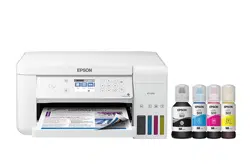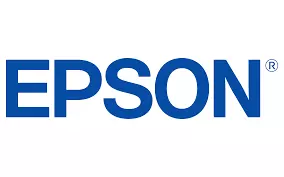Documents: Go to download!
User Manual
- User Manual - (English)
- Specification Sheet - (English)
- Notices and Warranty for U.S. and Canada. - (English)
- Installation Guide - (English)
- Product Basics
- Loading Paper
- Placing Originals on the Product
- Copying
- Printing from a Computer
- Printing on a Mac
- Scanning
- Refilling Ink
- Adjusting Print Quality
- Cleaning and Transporting Your Product
- Troubleshooting
Table of contents
User Manual Color Inkjet
Product Basics
Using the Control Panel
Control Panel Buttons and Lights
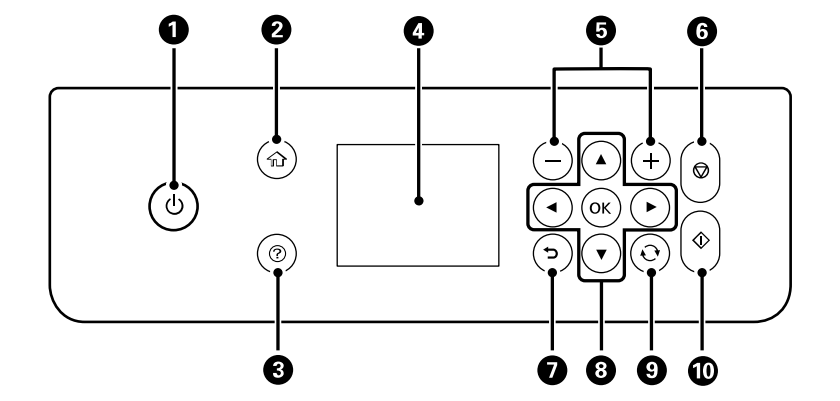

Status Icon Information
Your product displays status icons on the LCD screen for certain product status conditions. Select the  icon to view or change the current network settings.
icon to view or change the current network settings.
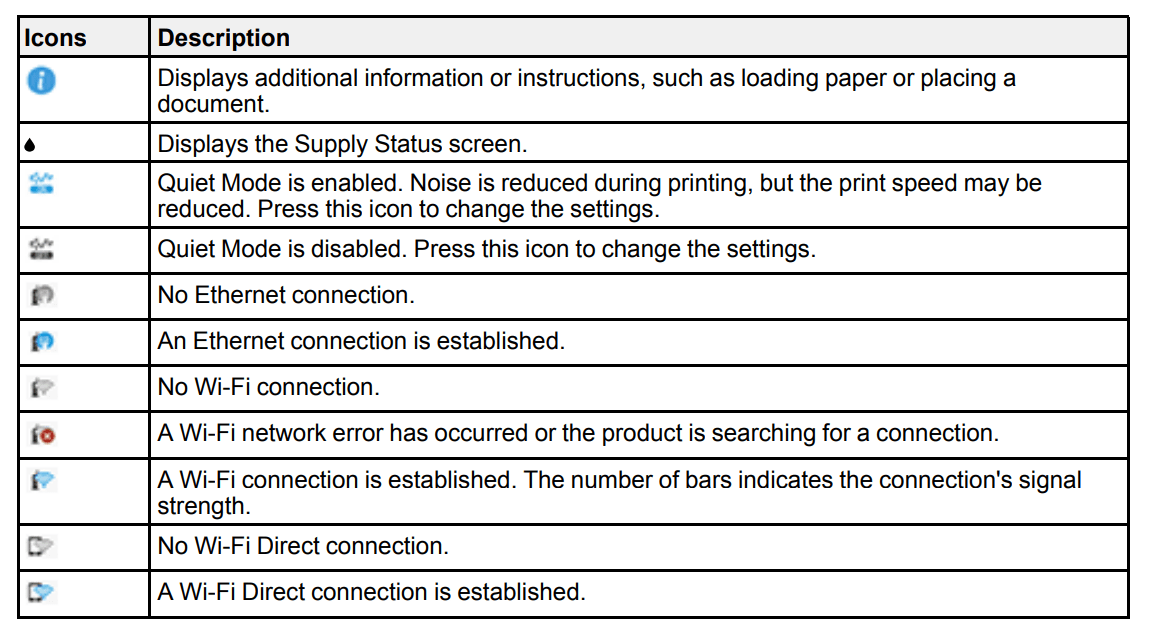
Entering Characters on the LCD Screen
Follow these guidelines to enter characters for passwords and other settings.
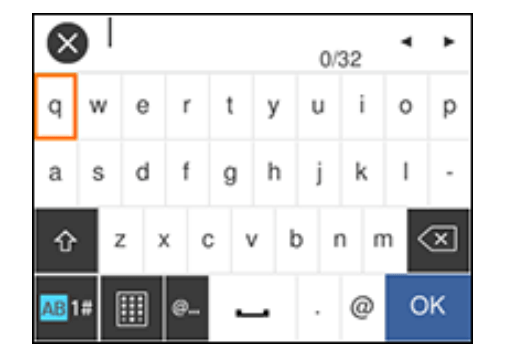
- To move the cursor, select the left or right arrows.
- To change the case of letters, select
 .
. - To delete the previous character, select
 .
. - To enter numbers or symbols, select AB1#.
- To enter a commonly used domain name, select @….
- To enter a space, select
 .
.
Changing LCD Screen Language
You can change the language used on the LCD screen.
1. Press the  home button, if necessary.
home button, if necessary.
2. Select Settings.
3. Select General Settings
- You see a screen like this:

4. Select Basic Settings.
5. Scroll down and select Language.
6. Select a language.
Adjusting the Screen Brightness
You can adjust the brightness of the LCD screen.
1. Press the  home button, if necessary.
home button, if necessary.
2. Select Settings.
3. Select General Settings.
You see a screen like this:
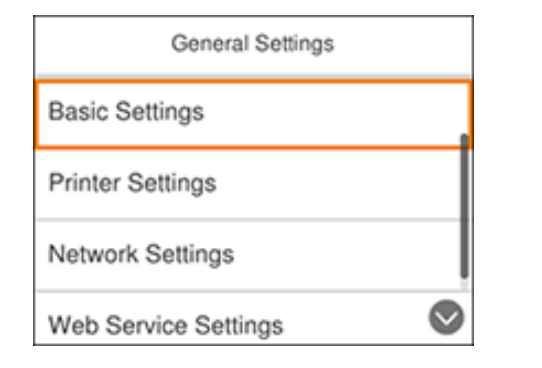
4. Select Basic Settings.
5. Select LCD Brightness.
6. Press the – or + icons to decrease or increase the brightness.
7. Select OK to exit
Turning Off the Operation Time Out Setting
The Operation Time Out setting causes the LCD screen to return to the Home screen after a few minutes of inactivity. This feature is enabled by default, but you can turn it off.
1. Press the  home button, if necessary.
home button, if necessary.
2. Select Settings.
3. Select General Settings.
You see a screen like this:
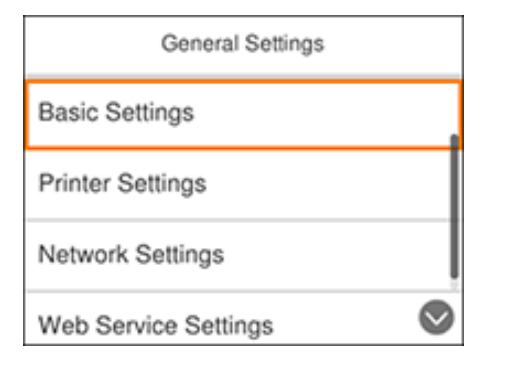
4. Select Basic Settings.
5. Scroll down and set Operation Time Out to Off.
Product Parts Locations
See these sections to identify the parts on your product.
Product Parts - Front
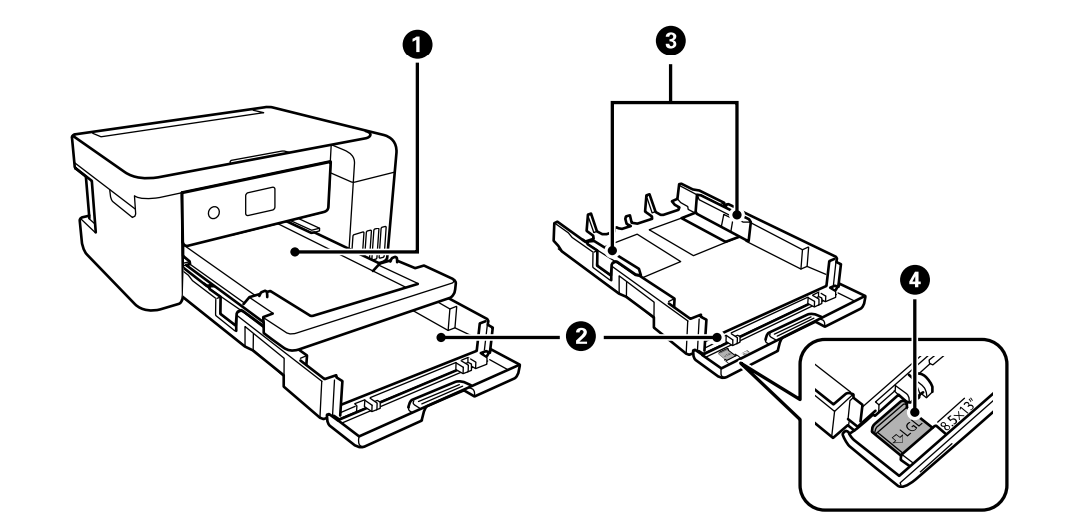
- Output tray
- Paper cassette
- Paper cassette edge guides
- Legal-size paper guide
Product Parts - Inside
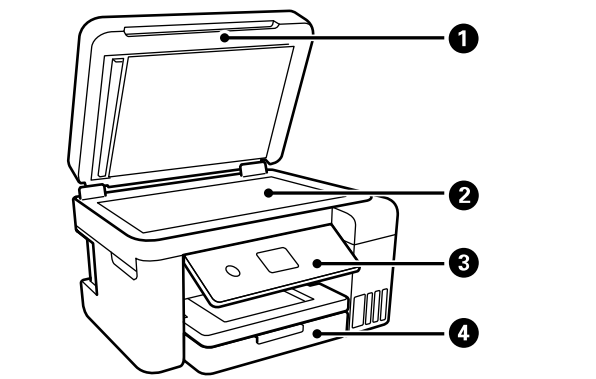
- Document cover
- Scanner glass
- Control panel
- Front cover
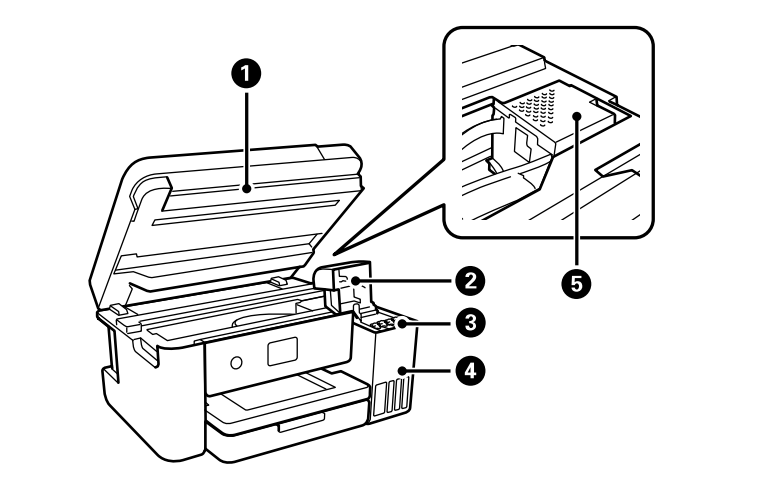
- Scanner unit
- Ink tank cover
- Ink tanks
- Ink tank unit
- Print head
Product Parts - Back
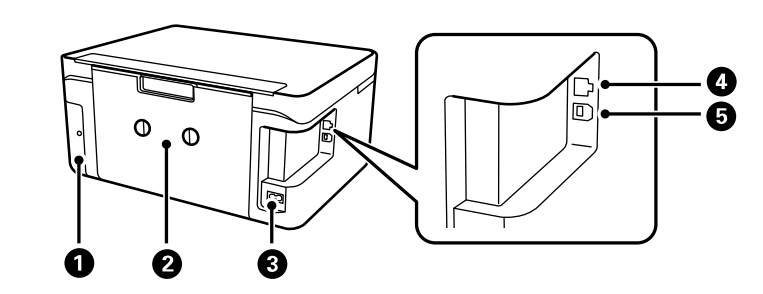
- Maintenance box cover
- Rear cover (duplexer)
- AC inlet
- LAN port
- USB port
Using Power Saving Settings
Changing the Sleep Timer Settings
You can adjust the time period before your product enters sleep mode and turns off the LCD screen.
1. Press the  home button, if necessary.
home button, if necessary.
2. Select Settings.
3. Select General Settings.
You see a screen like this:
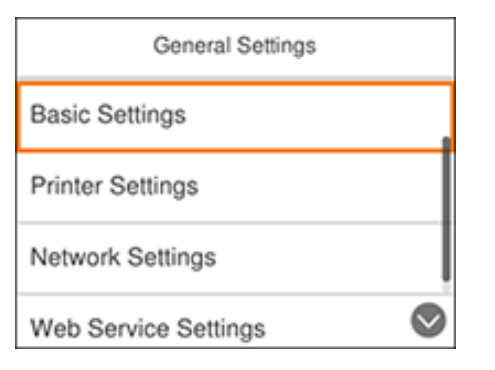
4. Select Basic Settings.
5. Select Sleep Timer.
You see a screen like this:

6. Do one of the following:
- Press the + or – button to increase or decrease the number of minutes.
- Press the OK button to display the on-screen keypad, select the number of minutes, and select OK.
7. Select OK.
Changing the Power Off Timer Settings
You can have the product turn off automatically if it is not used for a specified period of time.
1. Press the  home button, if necessary.
home button, if necessary.
2. Select Settings.
3. Select General Settings.
You see a screen like this:
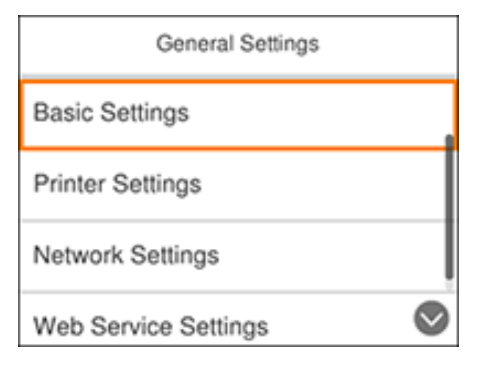
4. Select Basic Settings.
5. Select Power Off Timer, then select a time period between 30minutes and 12h (12 hours).
Epson Connect Solutions for Smartphones, Tablets, and More
Use your smartphone, tablet, or computer to print and scan documents, photos, emails, and web pages from your home, office, or even across the globe.
Note: If you are using your Epson product with the Windows 10 S operating system, you cannot use the software described in this section. You also cannot download and install any Epson product software 25 from the Epson website for use with Windows 10 S; you must obtain software only from the Windows Store.
Print from anywhere with these Epson Connect solutions:
- Epson Email Print
- Epson iPrint Mobile App
- Epson Remote Print
Scan and send a file as an email or upload it to an online service directly from your Epson product with Epson Scan to Cloud or the Epson iPrint Mobile App.
Setting Up Epson Connect Services
If you did not activate your product's email address for use with Epson Connect when you set up your product, you can activate it using the product control panel.
1. Press the  home button, if necessary.
home button, if necessary.
2. Select Settings.
3. Select General Settings.
You see a screen like this:
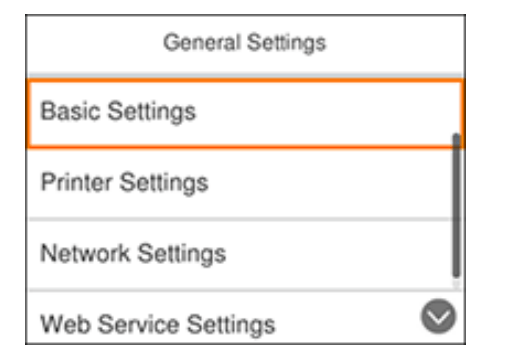
4. Select Web Service Settings.
5. Select Epson Connect Services
You see a screen like this:

6. Select Register.
7. Follow the instructions on the screen to activate your product's email address.
Using Epson Email Print
With Epson Email Print, you can print from any device that can send email, such as your smartphone, tablet, or laptop. Just activate your product's unique email address. When you want to print, attach a PDF, Microsoft Office document, or photo to an email and send it to your product. Both the email and the attachments will print automatically.
1. Connect your product to your network. See the link below.
2. If you did not already set up Email Print when you installed your product software, see the link below to use your product control panel to activate your unique email address. Or visit epson.com/connect (U.S), epson.ca/connect (Canada), or epsonconnect.com (Caribbean) to learn more about Email Print, create your Epson Connect account, and register your product to the Epson Connect service.
3. Now you are ready to send and print emails to your product's Email Print address.
Note: Go to epsonconnect.com and log into your Epson Connect account to personalize your product's email, adjust print settings, and set up other Epson Connect services.
Using the Epson iPrint Mobile App
Use this free Apple and Android app to print and scan with networked Epson products. Epson iPrint lets you print PDFs, Microsoft Office documents, photos, and web pages over a wireless network. You can scan and save a file on your device, send it as an email, or upload it to an online service such as Box, Dropbox, Evernote, or Google Drive.
1. Connect your product to your wireless network. See the link below.
2. Visit epson.com/connect (U.S), epson.ca/connect (Canada), or epson.com.jm/connect (Caribbean) to learn more about Epson iPrint and check the compatibility of your mobile device.
3. Download Epson iPrint from the Apple App Store or Google Play.
4. Connect your mobile device to the same wireless network as your product.
5. Open Epson iPrint and select your Epson product.
Using Epson Remote Print
With Epson Remote Print software, you can print from your laptop or desktop computer to an Epson Email-enabled product anywhere in the world.
- Connect your Epson product to your wireless network. See the link below.
- If you did not already set up an Epson Connect account when you installed your product software, visit epsonconnect.com to create your account and register your product to the Epson Connect service. Note: Make a note of your product's email address.
- Visit epsonconnect.com to learn more about Remote Print and how to download the Remote Print Driver software.
- Download and install the Remote Print software.
- Enter the email address and optional access key of your Epson product during Remote Print setup.
- Now you are ready to print remotely. Select the print command in your laptop or desktop computer application and choose the Remote Print option for your Epson product.
Using Epson Scan to Cloud
The Epson Scan to Cloud service allows you to scan and send a file as an email or upload it to an online service directly from your Epson product. Register an email address or online services such as Box, DropBox, Evernote, or Google Drive with your Epson Connect account.
- Connect your Epson product to your network. See the link below.
- If you did not already set up an Epson Connect account when you installed your product software, visit epsonconnect.com to create your account and register your product to the Epson Connect service.
- Note: Make a note of your product's email address and password.
- Visit epsonconnect.com to sign into your account with the email address and password you selected.
- Select your product, select Scan to Cloud, and select Destination List.
- Click Add, then follow the instructions on the screen to create your destination list.
- Now you are ready to use Scan to Cloud. Select the setting for scanning to Scan to Cloud on your Epson product control panel.
Using AirPrint
AirPrint enables instant wireless printing from iPhone, iPad, and iPod touch with the latest version of iOS, and Mac with the latest version of OS X or macOS.
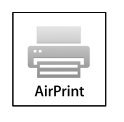
Note: If you disabled paper configuration messages on your product control panel, you cannot use AirPrint. See the link below to enable the messages, if necessary.
- Load paper in your product.
- Set up your product for wireless printing. See the link below.
- Connect your Apple device to the same wireless network that your product is using.
- Print from your device to your product.
Note: For details, see the AirPrint page on the Apple website.
Using Google Cloud Print
With a Google Account, you can print from your Apple or Android device to your Epson product. You can also print from Chromebooks and the Google Chrome browser without drivers or cables.
- Connect your Epson product to your wireless network. See the link below.
- Note your product's IP address by checking your network status. See the link below.
- Connect your computer or your mobile device to the same wireless network as your Epson product.
- Enter your product's IP address into the address bar of a web browser.
- Select the Google Cloud Print Services option.
- Note: If you don't see the Google Cloud Print Services option, turn your product off and back on. If the option still doesn't appear, select the Firmware Update option and follow the on-screen instructions to update your product.
- Click Register.
- Select the checkbox to agree to the Usage Advisory and click Next.
- Click OK to launch the sign-in page. A separate browser window opens.
- Enter your Google Account username and password and click Sign in, or, if you don't have an account, click Sign up for a new Google Account and follow the on-screen instructions.
- Click Finish printer registration to complete setup and print a test page.
Android Printing Using the Epson Print Enabler
You can wirelessly print your documents, emails, photos, and web pages right from your Android phone or tablet (Android v4.4 or later). With a few taps, your Android device will discover your nearby Epson product and print.
- Connect your Epson product to your wireless network. See the link below.
- On your Android device, download the Epson Print Enabler plug-in from Google Play.
- Go to Settings on your Android device, select Printing, and enable the Epson plug-in.
- Connect your Android device to the same wireless network as your product.
- Now you are ready to print. From an Android application such as Chrome or Gmail, tap the menu icon and print whatever is on the screen.
Note: If you do not see your product, tap All Printers and select your product.
Using Fire OS Printing
You can wirelessly print from Amazon Fire tablets and phones to your nearby networked Epson product. There is no software to download, no drivers to install, and no cables to connect. With just a few taps in Email, Calendar, Contacts, and WPS Office, you can send whatever is on the screen to an Epson product.
- Connect your Epson product to your wireless network. See the link below.
- Connect your Amazon device to the same wireless network as your product.
- Now you are ready to print. From your Amazon application, tap the print option and select your product to print whatever is on the screen.
Note: If you see a message telling you that a plug-in is required, tap OK and tap Download. If your Amazon Fire product uses Fire OS 5 and above, your device automatically uses the built-in Mopria Print Service app to print.
Using Windows 10 Mobile Printing
You can wirelessly print from Windows 10 Mobile tablets and phones to your nearby networked Epson product. There is no software to download, no drivers to install, and no cables to connect. Look for the print option in your Windows 10 application to send whatever is on the screen to an Epson product.
- Connect your Epson product to your wireless network. See the link below.
- Connect your Windows 10 Mobile device to the same wireless network as your product.
- Now you are ready to print. From your Windows 10 application, tap the print option and select your product to print whatever is on the screen.
Using Epson Print and Scan App with Windows Tablets
You can use this free app to print photos and scan from your Windows (Windows 8 or higher) Surface RT or Pro tablet with networked Epson products. Epson Print and Scan App allows you to scan and capture images right to your tablet or to Microsoft OneDrive.
Note: The Epson Print and Scan App does not support Windows 10 Mobile printing.
- Connect your Epson product to your wireless network. See the link below.
- Download Epson Print and Scan App from the Microsoft Windows Store.
- Connect your Windows tablet to the same wireless network as your product.
- Open Epson Print and Scan App and select your Epson product. Now you are ready to print photos or scan.
Loading Paper
Before you print, load paper for the type of printing you will do.
Loading Paper in the Cassette
You can load paper up to this size in the paper cassette: Legal (8.5 × 14 inches [216 × 356 mm]).
Note: Before loading paper, make sure your product is not currently printing, scanning, or copying.
1. Open the front cover.

2. Pull out the paper cassette until it stops.
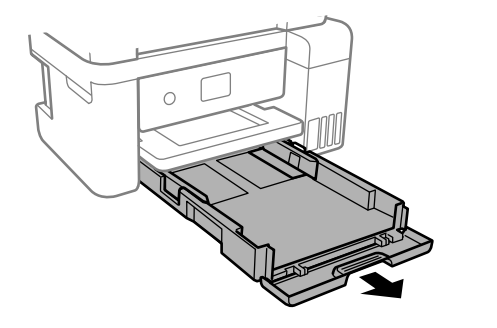
3. Slide the edge guides outward.
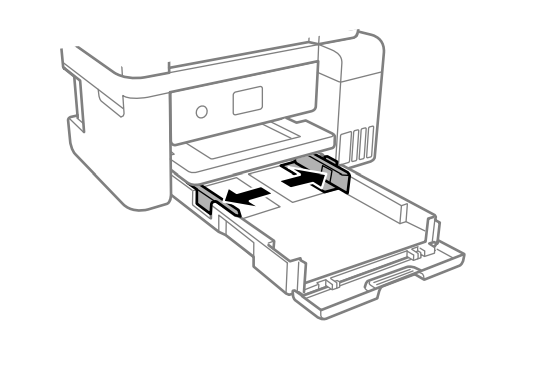
4. Do one of the following:
- Insert paper into the cassette with the glossy or printable side facedown and slide it in until it stops.
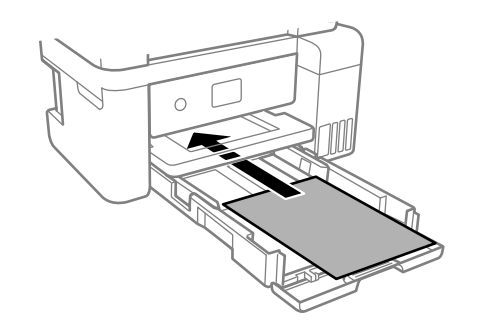
Note: Make sure the paper is loaded against the rear of the cassette.
- For legal-size paper, extend the legal paper guide and load paper using the guide line as shown.
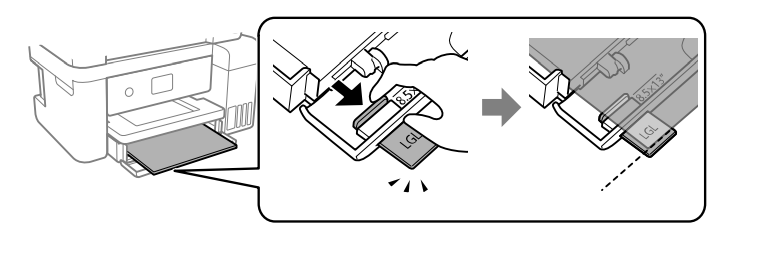
- Insert up to 10 envelopes with the printable side facedown and flap edge left, as shown
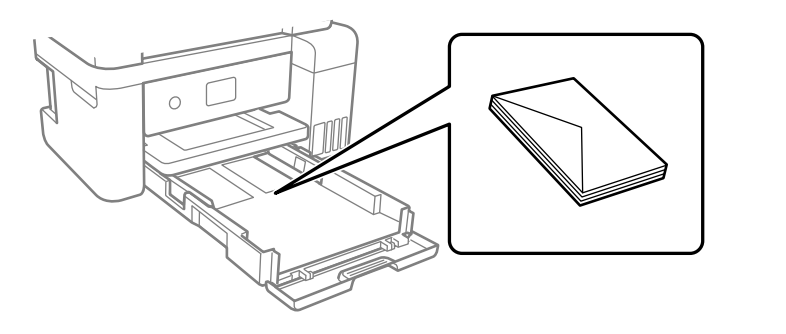
- Load a sheet of loose-leaf or other paper with holes as shown.
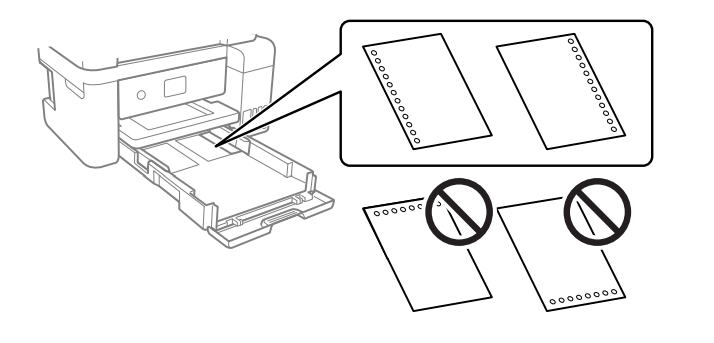
Note: Do not select automatic 2-sided printing for this type of paper and do not print over the holes.
5. Slide the edge guides against the paper, but not too tightly
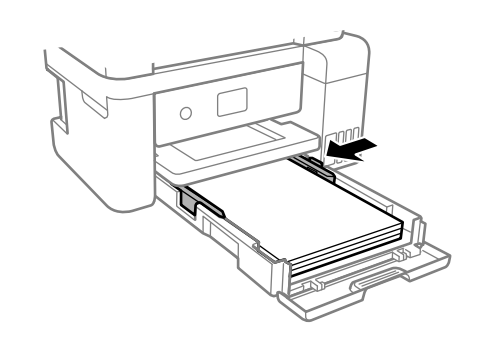
Note: Make sure the paper fits under the tabs on the edge guides.
6. Slide the cassette back into the product until it stops.
7. Select the size and type of the paper you loaded on the product LCD screen and select OK.
Note: If you are printing on letterhead, make sure you select Letterhead as the paper type. Make sure you select the correct paper size setting.
8. Extend the output tray
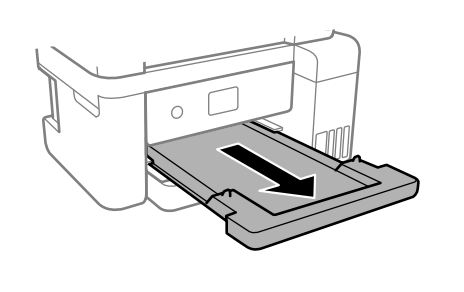
Note: Do not remove or insert the paper cassette during printing.
Always follow these paper loading guidelines:
- Load only the recommended number of sheets.
- Load paper short edge first and printable side facedown.
- Make sure the paper is under the tabs on the edge guides and not sticking out from the rear end of the cassette.
- If you have trouble loading a stack of envelopes, press each envelope flat before loading it or load one envelope at a time.
- If print quality declines when printing multiple envelopes, try loading one envelope at a time.
- Load letterhead or pre-printed paper top edge first.
- Check the paper package for any additional loading instructions.
Paper Loading Capacity
See the table here for the loading capacity of the paper cassettes.

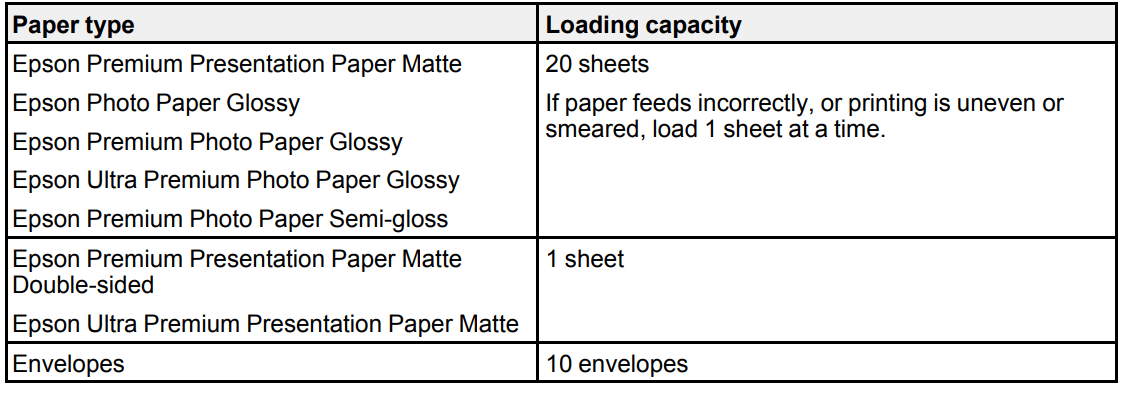
Double-sided Printing Capacity
You can print double-sided using Auto or Manual mode on the paper types and sizes listed here.
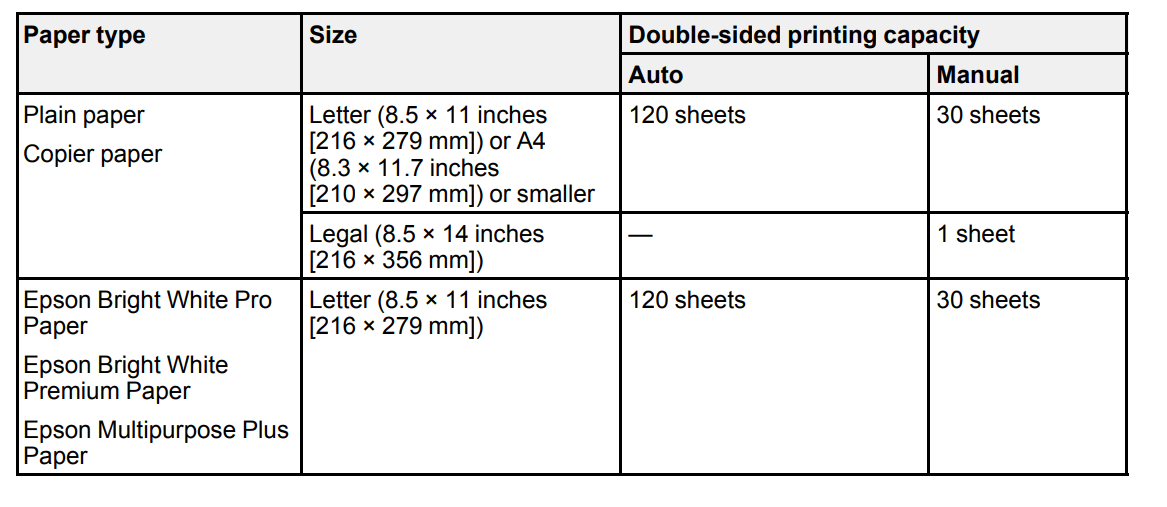

You cannot print double-sided on the following paper types:
- Epson Presentation Paper Matte
- Epson Photo Paper Glossy
- Epson Premium Photo Paper Glossy
- Epson Premium Photo Paper Semi-gloss
- Epson Ultra Premium Photo Paper Glossy
- Epson Premium Presentation Paper Matte
- Epson Ultra Premium Presentation Paper Matte
- Letterhead paper
- Envelopes
Placing Originals on the Product
Placing Originals on the Scanner Glass
You can place originals up to this size on the scanner glass: Letter (8.5 × 11 inches [216 × 279 mm]) or A4 (8.3 × 11.7 inches [210 × 297 mm]).
1. Open the document cover.
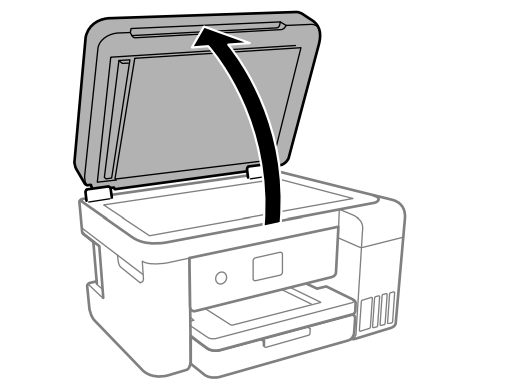
2. Place your original facedown on the scanner glass with the top facing into the corner. Slide the original to the edges of the indicated corner.
- Note: The edges of your original may be cropped by 0.06 inch (1.5 mm) from the edge of the scanner glass. Manually position your original away from the edges to prevent cropping.

3. Close the document cover gently to keep your original in place.
- Caution: Do not push down on the document cover or scanner glass or you may damage the product
Copying
See the information here to copy documents or photos using your product. Note: Copies may not be exactly the same size as your originals.
Copying Documents or Photos
You can copy documents or photos onto various sizes and types of paper, including Epson special papers.
1. Place your original document or photo on the scanner glass.
2. Load the paper you want to print on.
3. Press the home button, if necessary.
4. Select Copy.
You see a screen like this:

5. To print more than one copy, select Copies and use the + and - buttons to increase or decrease the number of copies.
6. Change any of the displayed settings as necessary.
7. Select Advanced Settings to view and change additional copy settings, if necessary.
8. When you are ready to copy, select the Copy icon.
Note: To cancel printing, select Cancel.
Copying Options
Select the copying options you want to use for your copies.
Note: Not all options or settings may be available, depending on other copying settings.
Copy

Advanced Settings

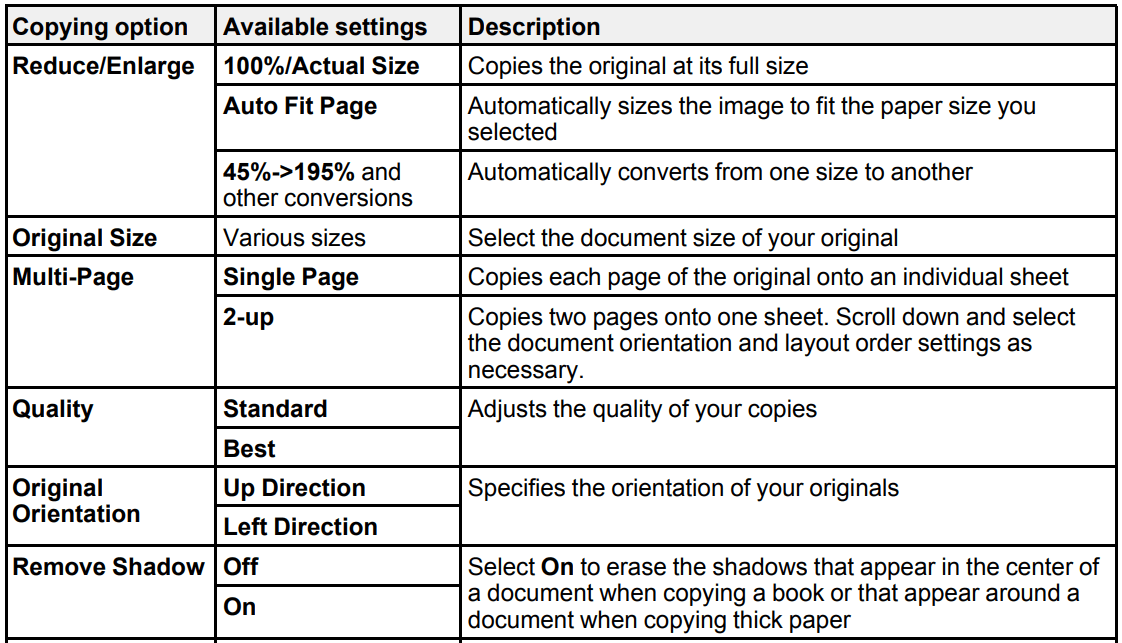

Printing from a Computer
Printing with Windows
You can print with your product using any Windows application, as described in these sections.
Note: If you are using your Epson product with the Windows 10 S operating system, you cannot use the software described in this section. You also cannot download and install any Epson product software from the Epson website for use with Windows 10 S; you must obtain software only from the Windows Store
Selecting Basic Print Settings - Windows
Select the basic settings for the document or photo you want to print.
1. Open a photo or document for printing.
2. Select the print command in your application. Note: You may need to select a print icon on your screen, the Print option in the File menu, or another command. See your application's help utility for details.
3. If necessary, select your product name as the printer you want to use.
- Note: You may also need to select Properties or Preferences to view your print settings.
- You see the Main tab of your printer settings window:
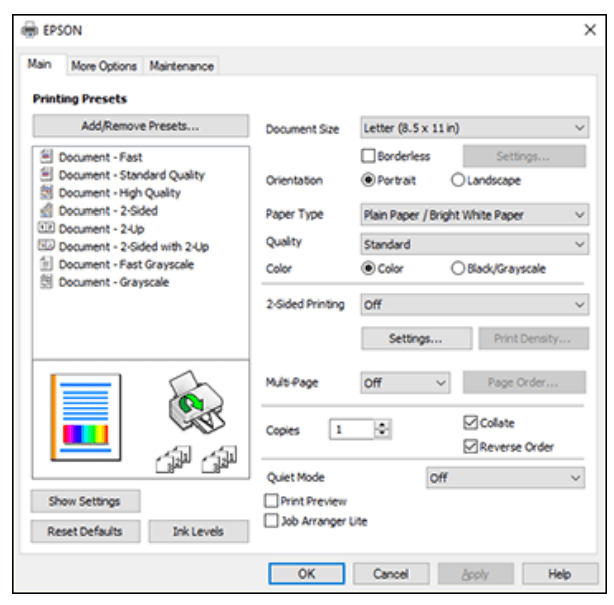
4. Select the size of the paper you loaded as the Document Size setting.
- Note: You can also select the User-Defined setting to create a custom paper size, but you cannot use the Borderless setting and the Quality setting will be set to Standard.
5. If you are printing a borderless photo, select Borderless.
- You can click Settings to access additional options for borderless printing.
- Note: You must select a compatible borderless paper type and size to print without borders. Check the borderless paper compatibility list for details.
6. Select the orientation of your document.
- Note: If you are printing an envelope, select Landscape.
7. Select the type of paper you loaded as the Paper Type setting.
- Note: The setting may not exactly match the name of your paper. Check the paper type settings list for details.
8. Select the Quality setting that matches the print quality you want to use.
9. Select a Color option:
- To print a color document or photo, select the Color setting.
- To print text and graphics in black or shades of gray, select the Black/Grayscale setting.
10. To print on both sides of the paper, select the 2-Sided Printing setting and select the options you want.
11. To print multiple pages on one sheet of paper, or print one image on multiple sheets of paper, select one of the settings in the Multi-Page menu and select the printing options you want.
12. To print multiple copies and arrange their print order, select the Copies options.
13. To preview your job before printing, select Print Preview.
14. To save your print job as a project that can be modified and combined with other print jobs, select Job Arranger Lite.
15. To reduce noise during printing when you select Plain Paper/Bright White Paper, select On in the Quiet Mode menu.
- Note: Enabling Quiet Mode may reduce printing speed.
Print Quality Options - Windows
You can select any of the available Quality options to fine-tune the quality of your print. Some settings may be unavailable, depending on the paper type and border setting you have chosen.
Draft
- For draft printing on plain paper.
Standard
- For everyday text and image printing.
Standard - Vivid
- For text and graphics with good quality and print speed.
High
- For photos and graphics with high print quality.
More Settings
- Opens a window that lets you choose among levels of speed and quality.
Selecting Double-sided Printing Settings - Windows
You can print on both sides of the paper by selecting one of the 2-Sided Printing options on the Main tab.
Note: Some options may be pre-selected or unavailable, depending on other settings you have chosen or if you are accessing the product over a network.

1. Select one of the following options for 2-Sided Printing:
- Auto (Long-edge binding) to print your double-sided print job by automatically flipping the paper on the long edge.
- Auto (Short-edge binding) to print your double-sided print job by automatically flipping the paper on the short edge.
- Manual (Long-edge binding) to print your double-sided print job by printing one side and prompting you to flip the paper over on the long edge to print the other side (recommended for paper types that do not support automatic duplexing).
- Manual (Short-edge binding) to print your double-sided print job by printing one side and prompting you to flip the paper over on the short edge to print the other side (recommended for paper types that do not support automatic duplexing).
2. Click the Settings button.
- You see this window:
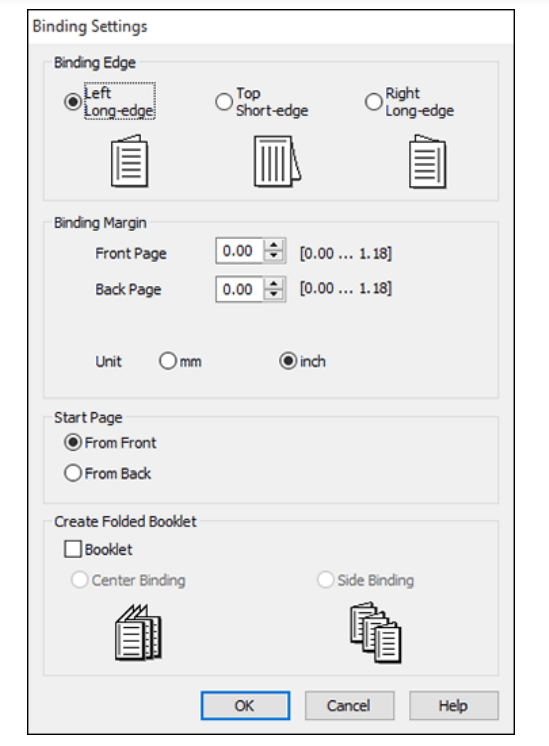
3. Select the double-sided printing options you want to use.
4. Click OK to return to the Main tab.
5. Click the Print Density button.
- You see this window:
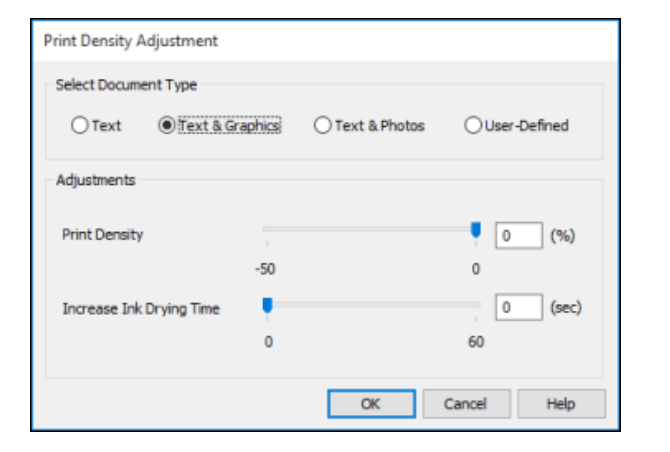
6. Select the type of document you are printing as the Document Type setting. The software automatically sets the Adjustments options for that document type.
7. If necessary, select the Adjustments options you want to use.
8. Click OK to return to the Main tab.
9. Print a test copy of your double-sided document to test the selected settings.
10. Follow any instructions displayed on the screen during printing
Double-sided Printing Options - Windows
You can select any of the available options on the Binding Settings window to set up your double-sided print job.
Binding Edge Options
- Select a setting that orients double-sided print binding in the desired direction.
Binding Margin Options
- Select options that define a wider margin to allow for binding.
Start Page
- Selects whether printing starts on the front or back page.
Create Folded Booklet Options
- Select the Booklet checkbox and a binding option to print double-sided pages as a booklet
Print Density Adjustments - Windows
You can select any of the available options on the Print Density Adjustment window to adjust the print quality of your double-sided print job.
Print Density
- Sets the level of ink coverage for double-sided printing.
Increase Ink Drying Time
- Sets the amount of time required for drying ink after printing on one side of the paper before printing the other side in double-sided printing to prevent ink smearing.
Selecting Additional Layout and Print Options - Windows
You can select a variety of additional layout and printing options for your document or photo on the More Options tab.
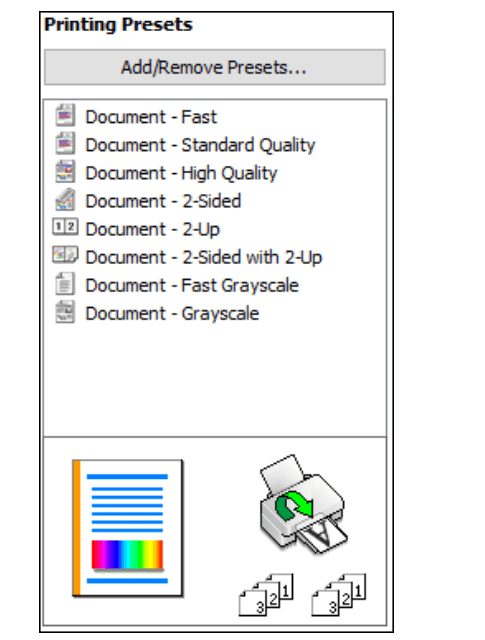
1. To change the size of your printed document or photo, select the Reduce/Enlarge Document checkbox and select one of these sizing options:
- Select the Fit to Page option to size your image to fit the paper you loaded. Select the size of your document or photo as the Document Size setting, and the size of your paper as the Output Paper setting. If you want to center your image on the paper, select the Center option.
- Select the Zoom to option to reduce or enlarge your document or photo by a specific percentage. Select the percentage in the % menu.
2. Select one of the following Color Correction options:
- Select Automatic to automatically adjust the sharpness, brightness, contrast, and color saturation for your image.
- Select Custom and click the Advanced button to manually adjust the color correction settings or turn off color management in your printer software.
- Select Image Options to access additional settings for improving printed images.
Note: You can also select Color Universal Print settings.
3. To add the following features, click the Watermark Features button:
- Anti-Copy Pattern: adds a watermark that only appears when your printout is copied
- Watermark: adds a visible watermark to your printout
- Header/Footer: adds information such as the date and time to the top or bottom of your printout
Note: Click the Settings button to customize the text and location of the header or footer.
4. Select any of the Additional Settings options to customize your print.
Selecting a Printing Preset - Windows
For quick access to common groups of print settings, you can select a printing preset on the Main or More Options tab.
Note: You can create your own preset by clicking the Add/Remove Presets button.
1. Click the Main or More Options tab.
- You see the available Printing Presets on the left:
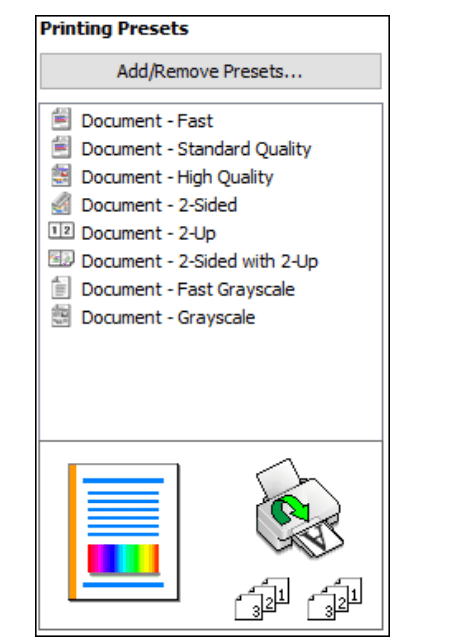
2. Place your cursor over one of the Printing Presets to view its list of settings.
3. Click on a preset to change its settings, or use any of the available options on the screen to control your printing presets.
4. To choose a preset for printing, select it.
5. Click OK
Selecting Extended Settings - Windows
You can select additional settings that apply to all the print jobs you send to your product.
1. Access the Windows Desktop and right-click the  icon for your product in the right side of the Windows taskbar, or click the up arrow and right-click
icon for your product in the right side of the Windows taskbar, or click the up arrow and right-click  .
.
2. Select Printer Settings.
3. Click the Maintenance tab.
- You see the maintenance options:
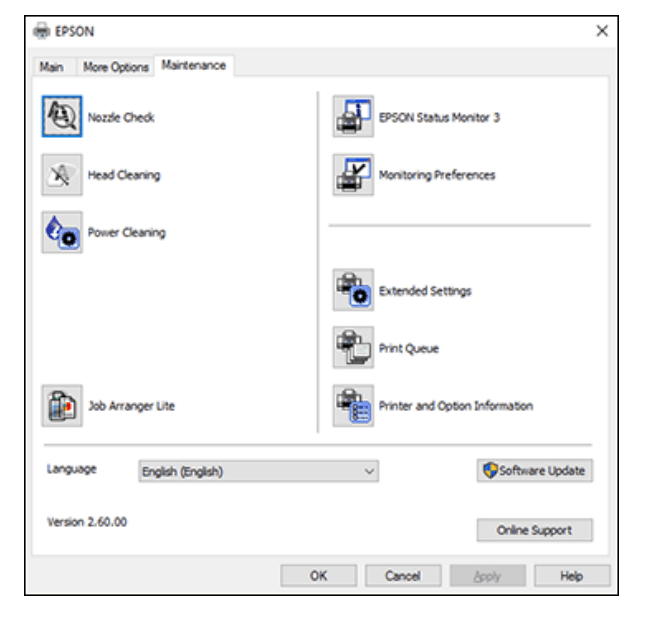
4. Click the Extended Settings button.
You see this window:

5. Select any of the extended settings to customize your print.
6. Click OK to close the Extended Settings window.
7. Click OK to close the printer software window.
Printing Your Document or Photo - Windows
Once you have selected your print settings, you are ready to save your settings and print.
1. Click OK to save your settings.
You see your application's Print window, such as this one:
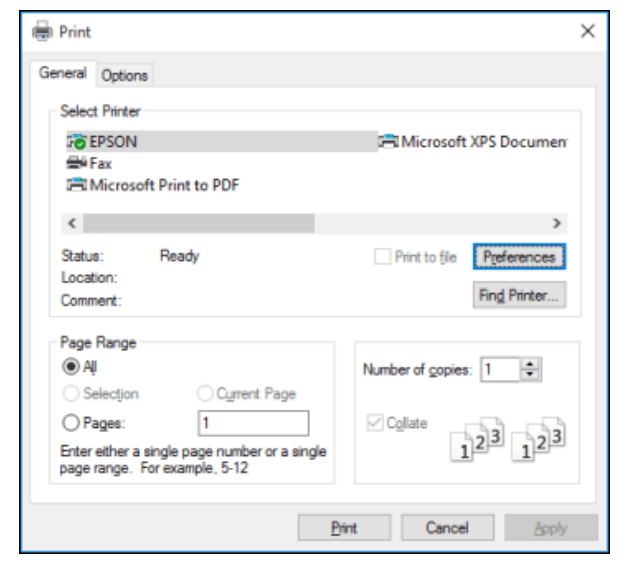
2. Click OK or Print to start printing.
Locking Printer Settings - Windows
1. Do one of the following:
- Windows 10: Click
 and select
and select  (Settings) > Devices > Printers & scanners. Select your product name and select Manage > Printer properties.
(Settings) > Devices > Printers & scanners. Select your product name and select Manage > Printer properties. - Windows 8.x: Navigate to the Apps screen and select Control Panel > Hardware and Sound > Devices and Printers. Right-click your product and select Printer properties.
- Windows 7: Click
 and select Devices and Printers. Right-click your product and select Printer properties.
and select Devices and Printers. Right-click your product and select Printer properties. - Windows Vista: Click
 and select Control Panel. Click Printer under Hardware and Sound, then right-click your product and select Properties.
and select Control Panel. Click Printer under Hardware and Sound, then right-click your product and select Properties.
2. Click the Optional Settings tab.
Note: You can prevent access to the Optional Settings tab by changing the user or group permissions in the Security tab.
3. Click Driver Settings.
- You see this window:
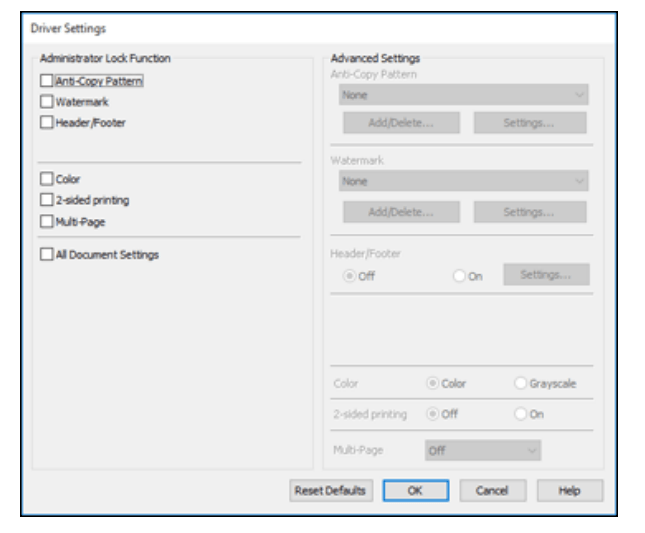
4. Select the checkbox for each setting you want to lock. To lock all print settings, select All Document Settings.
5. Under Advanced Settings, select the setting option you want to use for each locked setting.
6. Click OK.
Locked Setting Options

Selecting Default Print Settings - Windows
When you change your print settings in a program, the changes apply only while you are printing in that program session. If you want to change the print settings you use in all your Windows programs, you can select new default print settings.
1. Access the Windows Desktop and right-click the icon for your product in the right side of the Windows taskbar, or click the up arrow and right-click
icon for your product in the right side of the Windows taskbar, or click the up arrow and right-click  .
.
2. Select Printer Settings.
- You see the printer settings window:

3. Select the print settings you want to use as defaults in all your Windows programs.
4. Click OK.
These settings are now the defaults selected for printing. You can still change them as needed for printing in any program session.
Changing the Language of the Printer Software Screens
You can change the language used on the Windows printer software screens.
1. Access the Windows Desktop and right-click the  icon for your product in the right side of the Windows taskbar, or click the up arrow and right-click
icon for your product in the right side of the Windows taskbar, or click the up arrow and right-click  .
.
2. Select Printer Settings.
- You see the printer settings window.
3. Click the Maintenance tab.
- You see the maintenance options:
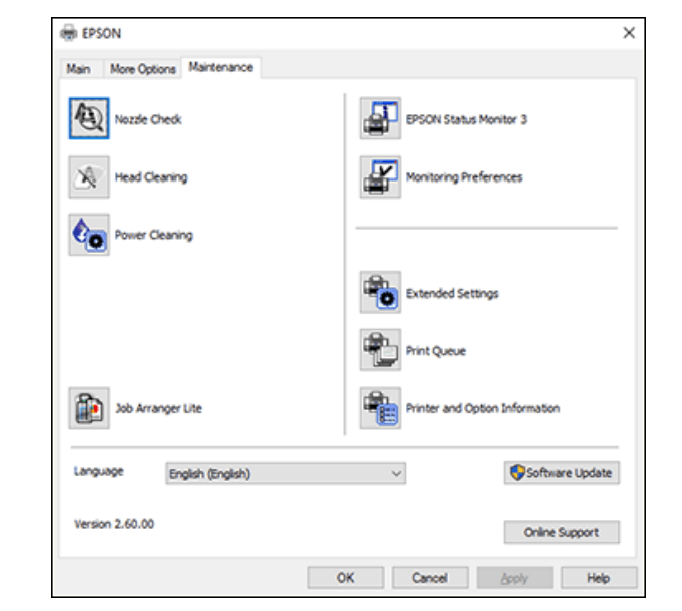
4. Select the language you want to use as the Language setting.
5. Click OK to close the printer software window.
Changing Automatic Update Options
Your printer software for Windows automatically checks for updates to the product software. You can change how often the software checks for updates or disable this feature.
1. Access the Windows Desktop and right-click the icon for your product in the right side of the Windows taskbar, or click the up arrow and right-click
icon for your product in the right side of the Windows taskbar, or click the up arrow and right-click  .
.
2. Select Software Update Settings.
You see this window:
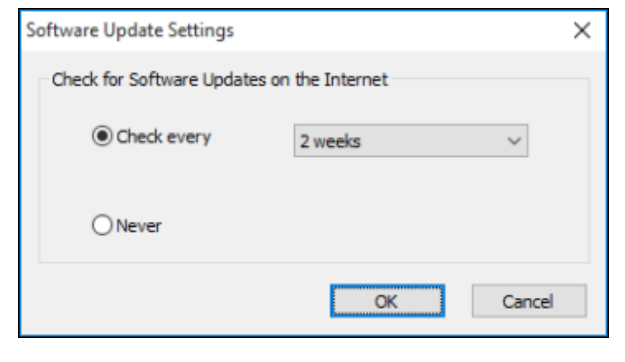
3. Do one of the following:
- To change how often the software checks for updates, select a setting in the Check every menu.
- To disable the automatic update feature, select the Never option.
4. Click OK to exit.
- Note: If you choose to disable the automatic update feature, you can check for updates manually.
Printing with the Built-in Epson Driver - Windows 10 S
You can print with the built-in Epson printer driver using any printing program on Windows 10 S, as described in these sections.
Note: The built-in Epson driver in Windows 10 S does not include all the available print settings for your product. To print with additional settings, download and install the Epson Print and Scan utility from the Windows Store. You cannot download and install any Epson product software from the Epson website for use with Windows 10 S; you must obtain software only from the Windows Store.
Selecting Print Settings - Windows 10 S
Select the settings for your print job in your Windows 10 S application.
1. Open a photo or document for printing.
2. Select the print command in your application.
Note: You may need to select a print icon on your screen, the Print option in the File menu, or another command. See your application's help utility for details.
3. If necessary, select your product name as the printer you want to use.
Note: You may also need to select Properties or Preferences to view your print settings.
You see a window like this:
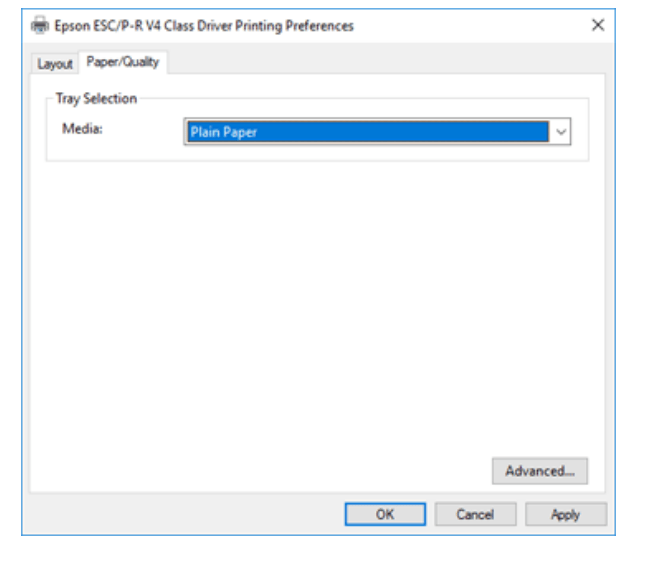
4. Select the type of paper you loaded as the Media setting.
Note: The setting may not exactly match the name of your paper. Check the paper type settings list for details.
5. Click the Advanced button.
You see a window like this:

6. Select the size of the paper you loaded as the Paper Size setting.
7. To print multiple copies, select or enter the number as the Copy Count setting.
8. To print multiple copies of multi-page documents in sets, select the Collated checkbox.
9. Click OK.
You return to the printing preferences window.
10. Select the Layout tab.
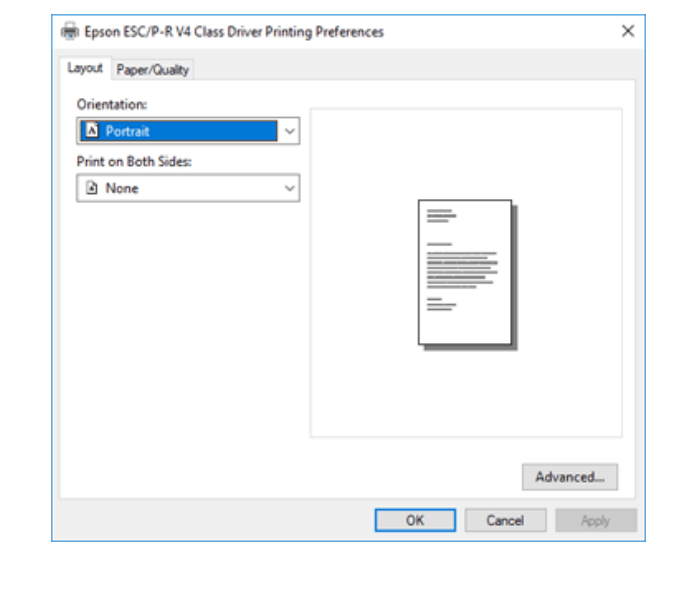
11. Select the orientation of your document as the Orientation setting.
12. Click OK to save your settings.
You see your application's Print window.
13. Click OK or Print to start printing.
Printing on a Mac
You can print with your product using any Mac printing program, as described in these sections.
Note: If you have an Internet connection, it is a good idea to check for updates to your product software on Epson's support website.
Selecting Basic Print Settings - Mac
Select the basic settings for the document or photo you want to print.
1. Open a photo or document for printing.
2. Select the print command in your application.
Note: You may need to select a print icon on your screen, the Print option in the File menu, or another command. See your application's help utility for details.
3. Select your product as the Printer setting.

4. If necessary, click the arrow next to the Printer setting or the Show Details button to expand the print window.
You see the expanded printer settings window for your product:
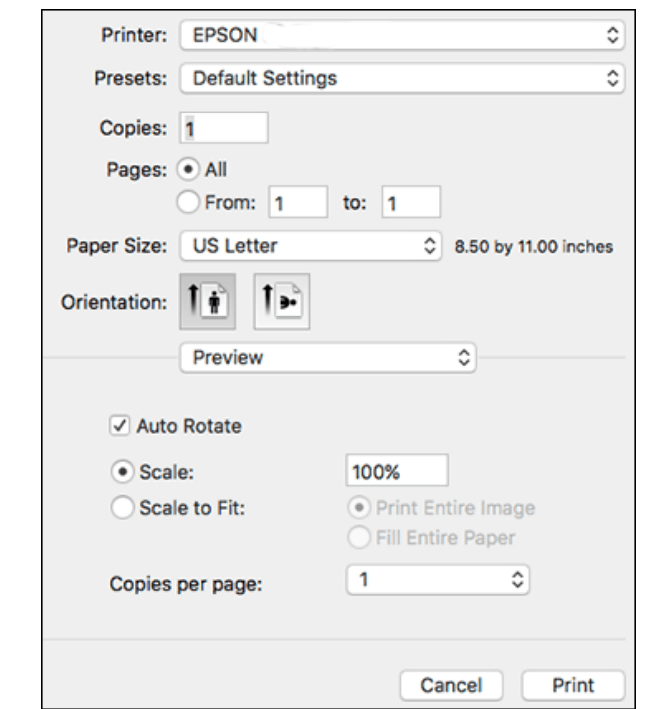
Note: The print window may look different, depending on the Mac OS version and the application you are using.
5. Select the Copies and Pages settings as necessary.
Note: If you do not see these settings in the print window, check for them in your application before printing.
6. Select the page setup options: Paper Size and Orientation.
Note: If you do not see these settings in the print window, check for them in your application before printing. They may be accessible by selecting Page Setup from the File menu.
7. Select any application-specific settings that appear on the screen, such as those shown in the image above for the Preview application.
8. Select Print Settings or Printer Features from the pop-up menu.
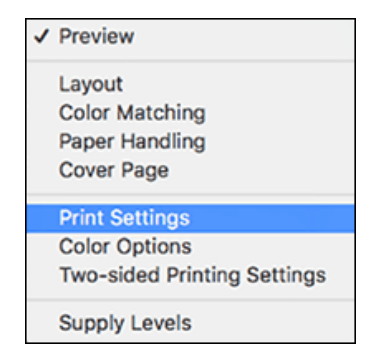
You see these settings:
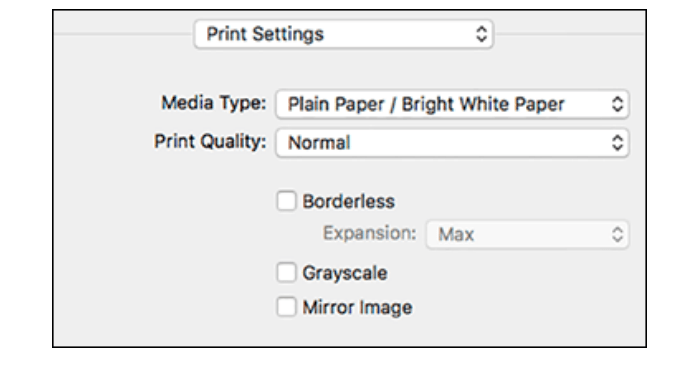
9. Select the type of paper you loaded as the Media Type setting.
Note: The setting may not exactly match the name of your paper. Check the paper type settings list for details.
10. Select the Print Quality setting you want to use.
11. Select the Borderless checkbox if you want to print a borderless photo. If the option is grayed out, change the Media Type setting to a paper type that supports borderless printing.
12. Select any of the available print options.
Selecting Page Setup Settings - Mac
Depending on your application, you may be able to select the paper size and orientation settings from the print window.

Note: If you do not see these settings in the print window, check for them in your application before printing. They may be accessible by selecting Page Setup from the File menu.
1. Select the size of the paper you loaded as the Paper Size setting. If you are printing a borderless photo, select the Borderless checkbox or a paper size with a Borderless option.
You can also select a custom setting to create a custom paper size, but the Quality setting will be limited to Normal.
- Note: You must select a compatible borderless paper type and size to print without borders. Check the borderless paper compatibility list for details.
2. Select the orientation of your document or photo as shown in the print window.
- Note: If you are printing an envelope, select the icon.
- Note: You can reduce or enlarge the size of the printed image by selecting Paper Handling from the pop-up menu and selecting a scaling option.
Selecting Print Layout Options - Mac
You can select a variety of layout options for your document or photo by selecting Layout from the popup menu on the print window.
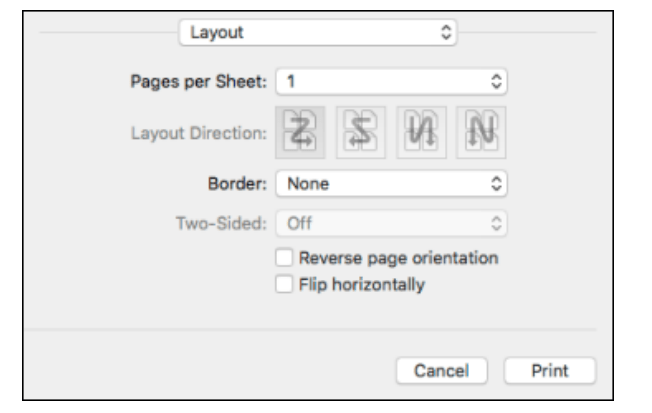
- To print multiple pages on one sheet of paper, select the number of pages in the Pages per Sheet pop-up menu. To arrange the print order of the pages, select a Layout Direction setting.
- To print borders around each page on the sheet, select a line setting from the Border pop-up menu.
- To invert or flip the printed image, select the Reverse page orientation or Flip horizontally settings.
Selecting Double-sided Printing Settings - Mac
You can print on both sides of the paper by selecting Two-sided Printing Settings from the pop-up menu on the print window.

Note: Some options may be pre-selected or unavailable, depending on other settings you have chosen or if you are accessing the product over a network. This screen may be different, depending on the Mac OS version you are using.
1. Select one of the Two-sided Printing options.
2. Select the type of document you are printing as the Document Type setting. The software automatically sets the Adjustments options for that document type.
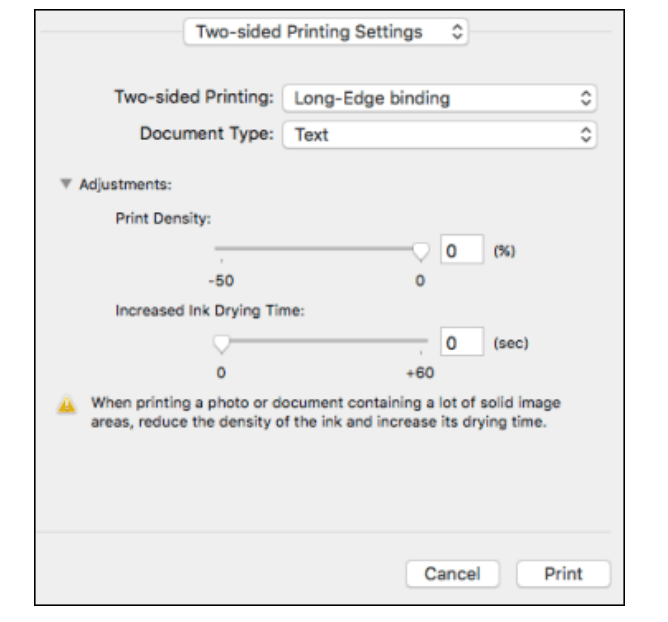
3. If necessary, customize the Adjustments settings as instructed on the screen.
4. Print a test copy of your double-sided document to test the selected settings.
5. Follow any instructions displayed on the screen during printing.
Managing Color - Mac
You can adjust the Color Matching and Color Options settings to fine-tune the colors in your printout, or turn off color management in your printer software.
1. Select Color Matching from the pop-up menu in the print window.

2. Select one of the available options.
3. Select Color Options from the pop-up menu in the print window.

Note: The available settings on the Color Options menu depend on the option you selected on the Color Matching menu.
4. Select one of the available options.
Selecting Printing Preferences - Mac
You can select printing preferences that apply to all the print jobs you send to your product.
1. In the Apple menu or the Dock, select System Preferences.
2. Select Print & Fax, Print & Scan, or Printers & Scanners, select your product, and select Options & Supplies.
3. Select Driver or Options.
- You see a screen like this:
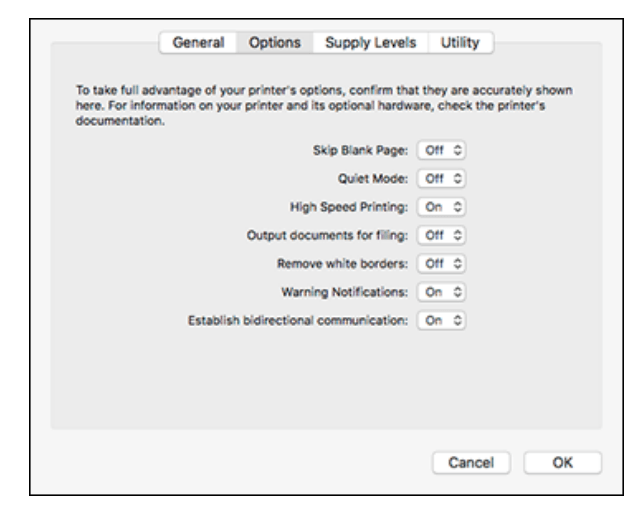
4. Select any of the available printing preferences.
5. Click OK.
Printing Your Document or Photo - Mac
Once you have selected your print settings, you are ready to print.
Click Print at the bottom of the print window.

Checking Print Status - Mac
During printing, you can view the progress of your print job, control printing, and check ink status.
1. Click the printer icon when it appears in the Dock.
You see the print status window:
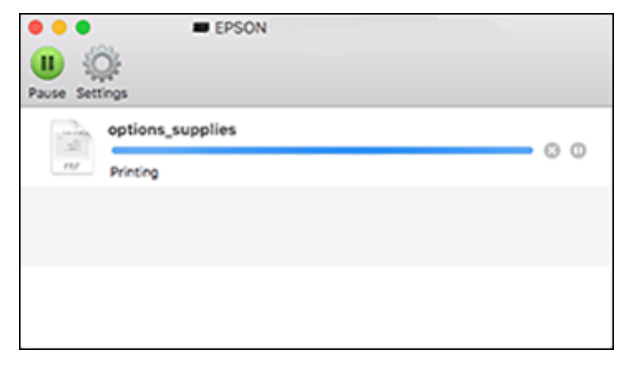
2. Select the following options as necessary for your Mac OS version:
- To cancel printing, click the print job and click
 or Delete.
or Delete. - To pause a print job, click the print job and click
 or Hold. To resume a print job, click the paused print job and click
or Hold. To resume a print job, click the paused print job and click  or Resume.
or Resume. - To pause printing for all queued print jobs, click Pause or Pause Printer.
- To display other printer information, click Settings or Supply Levels.
Printing From a Chromebook
With a Google Account, you can print from a Chromebook without drivers or cables.
- Connect your Epson product to your wireless network. See the link below.
- Turn on your Chromebook and connect it to the same wireless network as your product. Note: See your Chromebook's documentation for details on connecting to a network.
- Do one of the following:
- Click Add to Cloud Print in the notification that appears in the corner of your Chromebook screen.
- Note: If you do not see a notification, check to see if a number appears in the status area at the lower-right corner of the screen. Click this number to open the notifications menu, then click Add to Cloud Print.
- Open a web browser and enter chrome://devices in the address bar. Skip to step
- If you see a registration confirmation screen instead, click Register.
- Click Add to Cloud Print in the notification that appears in the corner of your Chromebook screen.
- Click Add Device.
- Click the Register button that appears next to your product.
- Click Register on the confirmation screen. Your product's LCD screen displays a confirmation message.
- Select OK or press the OK button on your product to confirm the Google Cloud Print connection and print a test page.
- To print to the connected product, select the print command in your Chrome app
Cancelling Printing Using the Product
If you need to cancel printing, select Cancel, then select Cancel again to confirm.
Scanning
Starting a Scan
Starting a Scan Using the Product Control Panel
You can scan an image to a variety of destinations using your product's control panel.
1. Make sure you installed the product software and connected the product to your computer or network.
- Note: Restart your computer after installing the product software to enable scanning from the control panel.
2. Place your original on the product for scanning.
3. Press the home button, if necessary.
4. Select Scan.
- You see a screen like this:
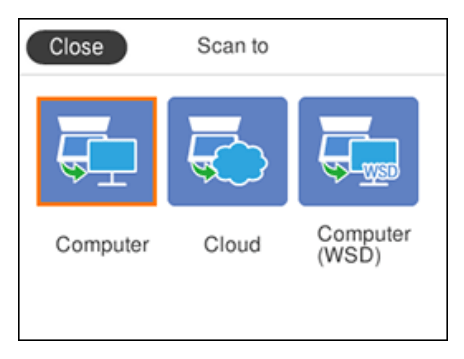
5. Select one of the following Scan to options:
- Computer lets you scan to a connected computer using your saved scan settings.
- Cloud sends your scanned files to a destination that you have registered with Epson Connect.
- Computer (WSD) lets you manage network scanning in Windows 10, Windows 8.x, Windows 7, or Windows Vista (English only). To use this feature, you must first set up a WSD (Web Services for Devices) port on your Windows 7 or Windows Vista computer (the port is set up automatically on Windows 10 and Windows 8.x).
6. Follow the instructions in the links below to complete your scan.
Scanning to a Connected Computer
You can scan an original and save it to a connected computer using your product's control panel. The computer must be connected using a USB cable or connected to the same network as your product.
You can save the scanned file as a JPEG or PDF file, or attach it to an email. You can also set up custom scan settings using Event Manager and automatically scan using those settings on your product control panel.
Note: Be sure you have installed Epson Scan 2 and Event Manager on your computer before scanning to your computer.
1. Place your original on the product for scanning.
2. Press the home button, if necessary.
home button, if necessary.
3. Select Scan.
- You see a screen like this:
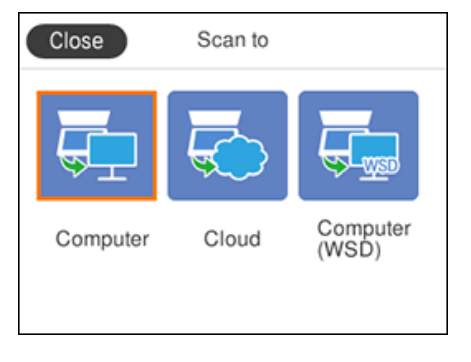
4. Select Computer.
- You see a screen like this:
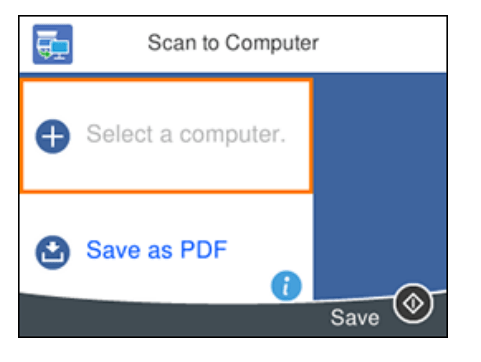
5. Select OK to close the information screen, if necessary.
6. Select Select a computer and choose one of the following options:
- If your computer is connected to your product over a network, select a connected computer from the displayed list. (If the computer is not listed, select Search Again.)
- If your computer is connected to your product using a USB cable, select USB Connection.
7. Select Save as PDF and choose one of the following options:
- Save as JPEG to save the scanned image as a JPEG file.
- Save as PDF to save the scanned document or image as a PDF file.
- Attach to email to open the default email software on your computer and save the scanned document or images as an email attachment.
- Follow custom setting to save the scanned document or image using custom settings you have selected using the Event Manager custom scan settings option. Note: You can customize the settings for each of these options using Event Manager.
8. Select Save to start scanning.
Control Panel Scanning Options
Select the options you want to use for scanning. Note: Not all options or settings may be available, depending on the Scan to option selected.
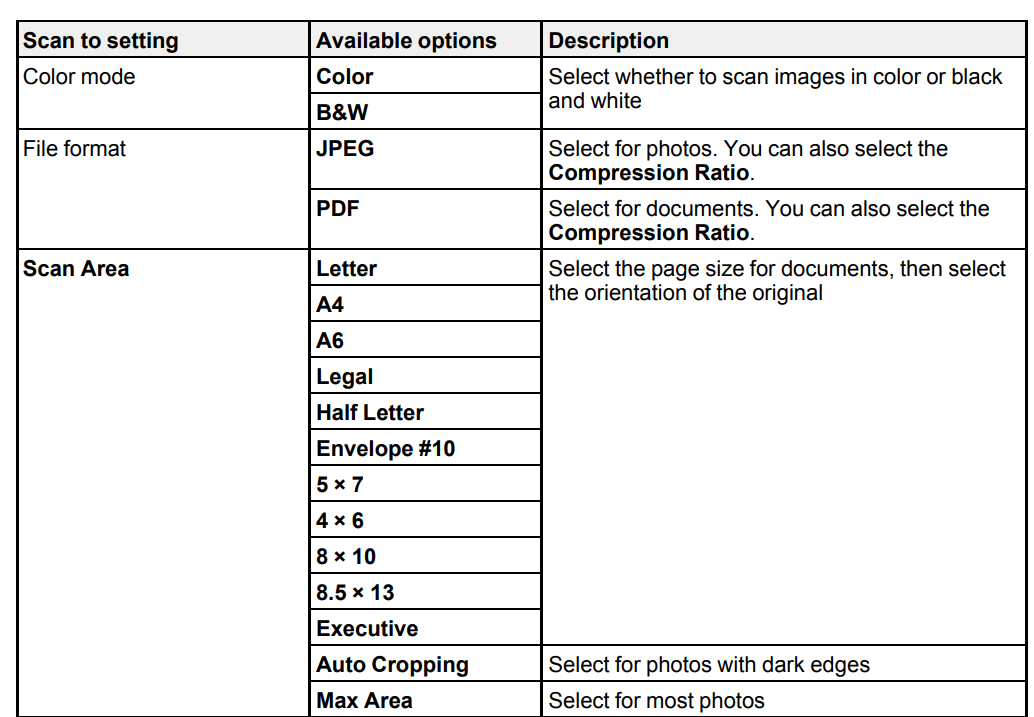


Changing Default Scan Job Settings
You can view or change the default scan job settings your product uses when you scan to your computer. You do this using the Event Manager program.
- Do one of the following to open Event Manager:
- Windows 10: Click
 and select EPSON Software > Event Manager.
and select EPSON Software > Event Manager. - Windows 8.x: Navigate to the Apps screen and select Event Manager.
- Windows (other versions): Click
 or Start > All Programs or Programs > EPSON Software > Event Manager.
or Start > All Programs or Programs > EPSON Software > Event Manager. - Mac: Open the Applications folder, click Epson Software, and select Event Manager.
- Windows 10: Click
- Open the Scanner (Windows) or Select Scanner (Mac) drop-down list and select your product, if necessary.
- Click Make Job Settings.
- Open the Edit Job Settings drop-down list and select the scan job settings you want to view or change.
- Change the settings as necessary.
- Note: If you create a new job, you can only assign it to the Custom Action setting.
- You can change the settings of the other assigned jobs, but you cannot rename them or select a different job.
- Click OK.
- Click Close to close the Event Manager window.
Starting a Scan Using the Epson Scan 2 Icon
You can start the Epson Scan 2 program to select scan settings, scan, and save the scanned image to a file.
Note: If you are using your Epson product with the Windows 10 S operating system, you cannot use the software described in this section. You also cannot download and install any Epson product software from the Epson website for use with Windows 10 S; you must obtain software only from the Windows Store
- Windows 10: Click
 and select EPSON > Epson Scan 2.
and select EPSON > Epson Scan 2. - Windows 8.x: Navigate to the Apps screen and select Epson Scan 2.
- Windows (other versions): Click
 or Start, and select All Programs or Programs. Select EPSON > Epson Scan 2 > Epson Scan 2.
or Start, and select All Programs or Programs. Select EPSON > Epson Scan 2 > Epson Scan 2. - Mac: Open the Applications folder, open the Epson Software folder, and select Epson Scan 2.
You see an Epson Scan 2 window like this:
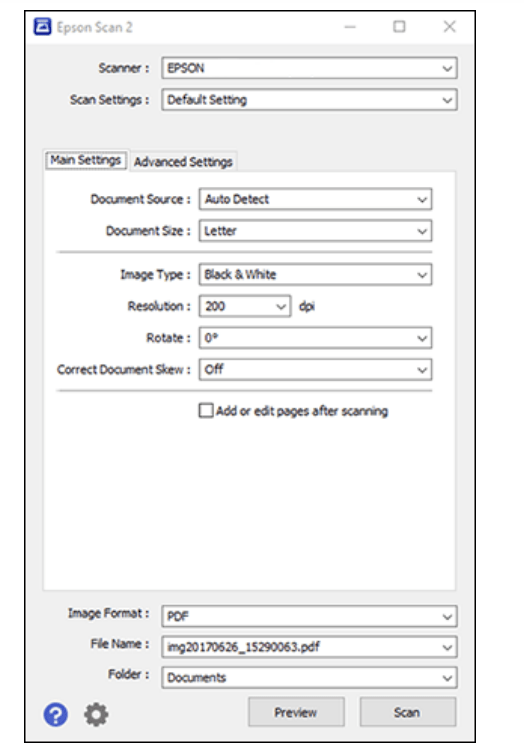
Starting a Scan from a Scanning Program
You can start Epson Scan 2 from a TWAIN-compliant scanning program to select scan settings, scan, and open the scanned image in the program.
Note: If you are using your Epson product with the Windows 10 S operating system, you cannot use the software described in this section.
You also cannot download and install any Epson product software from the Epson website for use with Windows 10 S; you must obtain software only from the Windows Store.
- Open your scanning program and select its scanning option. (See your scanning program help for instructions.)
- Select your product.
- Note: In certain programs, you may need to select your product as the "source" first. If you see a Select Source option, choose it and select your product. With Windows, do not select a WIA option for your product; not all scan functions will be available.
- You see an Epson Scan 2 window like this:

Starting a Scan from a Smart Device
You can start a scan from a smart device using the Epson iPrint app. You can save the scanned document to your device or a cloud service, e-mail it, or print it.
Note: If you are using your Epson product with the Windows 10 S operating system, you cannot use the software described in this section. You also cannot download and install any Epson product software from the Epson website for use with Windows 10 S; you must obtain software only from the Windows Store.
Note: Your device must be connected to the same wireless network as your Epson product.
- Download the Epson iPrint app from your device's app store or from Epson's website.
- Place your original on the product for scanning.
- Open the Epson iPrint app and select your product.
- Select the scan settings and scan your original.
- Save your scanned image to a file or cloud location.
Scanning in Epson Scan 2
Epson Scan 2 automatically scans your document and saves the scanned file in PDF format in your operating system's Documents or My Documents folder, or opens it in your scanning program. You can select settings, preview, and change the scanned file settings as necessary.
Note: If you are using your Epson product with the Windows 10 S operating system, you cannot use the software described in this section. You also cannot download and install any Epson product software from the Epson website for use with Windows 10 S; you must obtain software only from the Windows Store.
1. Start Epson Scan 2.
You see this window:

2. Select the Document Source setting that matches where you placed your original.
3. Select the Document Size setting that matches the size of your original. You can select Customize to enter a custom size, if necessary.
4. Select the image type of your original and how you want it scanned as the Image Type setting.
5. Select the Resolution setting you want to use for your scan.
6. Click the Preview button.
Epson Scan 2 previews your original and displays the results in the Epson Scan 2 window.
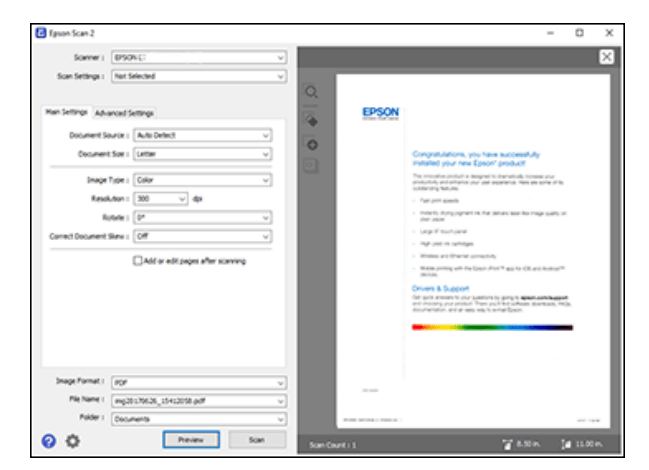
7. Select any of the additional settings that you want to use on the Main Settings tab. 8. Click the Advanced Settings tab and select any settings that you want to use.
9. Select the format in which you want to save your scanned file as the Image Format setting. If necessary, select Options and select any desired format options.
10. Enter the file name for your scanned file in the File Name field. If necessary, select Settings to modify the file name settings.
11. Select the location in which you want to save your scanned file as the Folder setting. If necessary, select Select to create a new folder.
12. Click Scan. The product scans your original and saves the scanned file in the location you specified.
Additional Scanning Settings - Main Settings Tab
You can select these additional scanning settings on the Epson Scan 2 Main Settings tab. Not all adjustment settings may be available, depending on other settings you have chosen.
Correct Document Skew
- Corrects skewed originals, image contents, or both.
Add or edit pages after scanning
- Lets you add, remove, or edit the pages in a scan, including rotating pages and changing the page order.
Note: To save multiple pages in a single file, you must select a file format that supports multiple pages such as PDF or Multi-TIFF. If you select another file format, each scanned image or page is saved as a separate file.
Additional Scanning Settings - Advanced Settings Tab
You can select these additional scanning settings on the Epson Scan 2 Advanced Settings tab. Not all adjustment settings may be available, depending on other settings you have chosen
- Remove Background
- Removes the background of the originals.
- Text Enhancement
- Sharpens the appearance of letters in text documents.
- Auto Area Segmentation
- Makes black and white images clearer and text recognition more accurate by separating the text from the graphics.
- Threshold
- Adjusts the level at which black areas in text and line art are delineated, improving text recognition in OCR (Optical Character Recognition) programs.
- Color Enhance
- Enhances the shades of the color you select in the scanned image. This setting is available only if you select Grayscale or Black & White as the Image Type setting.
- Brightness
- Adjusts the overall lightness and darkness of the scanned image.
- Contrast
- Adjusts the difference between the light and dark areas of the overall scanned image.
- Gamma
- Adjusts the midtone density of the scanned image.
- Unsharp Mask
- Makes the edges of certain image areas clearer. Turn off this option to leave softer edges.
- Descreening
- Removes the ripple pattern that might appear in subtly shaded image areas, such as skin tones. This option improves results when scanning magazines or newspapers. (The results of descreening do not appear in the preview image, only in your scanned image.)
- Edge Fill
- Corrects shadowing around the edges of the image by filling the shadows with black or white.
- Dual Image
- Output Scans the original image twice using different output settings (Windows only).
Saving Scanned Documents as a Searchable PDF Using Epson Scan 2
You can scan a document and save the text in a searchable PDF. In a searchable PDF, text is recognized using Optical Character Recognition (OCR) and then embedded in the scanned original.
1. Load your original in the product for scanning.
2. Start Epson Scan 2.
3. Select your scan settings.
4. Click Preview and adjust the area you want to scan, if necessary.
5. Select Searchable PDF as the Image Format setting.
6. Select Options from the Image Format list.
- You see this window:
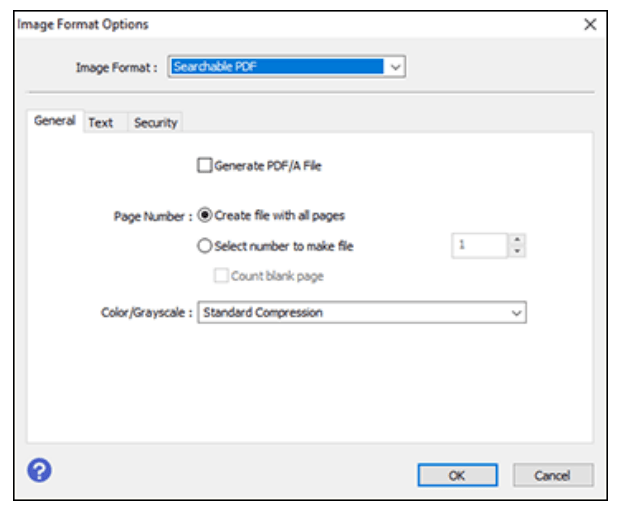
7. Select any of the options on the General tab.
8. Select the Text tab.
9. Make sure the language used in the document text is selected as the Text Language setting.
10. Select the Security tab if you want to add a password to the PDF or protect printing or editing properties.
11. Click OK.
12. Confirm the File Name setting and select a Folder setting for your document.
13. Click Scan.
The scanned image is saved as a searchable PDF.
Image Format Options
You can select different image formats and related options. For details on available options, click the ? icon on the Epson Scan 2 Image Format Options window. Not all image formats have options.
- BITMAP (*.bmp)
- A standard image file format for most Windows programs.
- JPEG (*.jpg)
- An image format that lets you highly compress image data. However, the higher the compression, the lower the image quality. (The TIFF format is recommended when you need to modify or retouch your scanned image.)
- PNG (*.png)
- An image format that does not lose quality during editing.
- TIFF (*.tif)
- A file format created for exchanging data between many programs, such as graphic and DTP software.
- Multi-TIFF (*.tif)
- A TIFF file format when multiple pages are saved to the same file, allowing you to edit the images using a compatible program.
- PDF (*.pdf)
- A document format that is readable by Windows and Mac systems using Adobe Reader, Acrobat, or other programs. You can save multi-page documents in one PDF file.
- Searchable PDF (*.pdf)
- A document format that is readable by Windows and Mac systems using Adobe Reader, Acrobat, or other programs. You can save multi-page documents in one PDF file. Recognized text in the scanned document can be searched.
Scan Resolution Guidelines
The Resolution setting, measured in dpi (dots per inch), controls the amount of detail captured in your scans. Increasing the resolution raises the amount of detail captured but comes with the following disadvantages:
- Larger file sizes
- It takes longer to scan your originals, send/receive your scans by email or fax, and to print your scans
- The image may become too large to fit on your display or print on paper If you plan to enlarge a scanned image so you can print it at a larger size, you may need to increase the resolution from the default resolution set by Epson Scan 2.
Follow these guidelines to determine the resolution setting you need:
- You will scan the image at its original size but enlarge it later in an image-editing program.
Increase the Epson Scan 2 Resolution setting in your scan. Increase the resolution by the same amount you will increase the image size to retain a high image quality. For example, if the resolution is 300 dpi (dots per inch) and you will double the image size later, change the Resolution setting to 600 dpi.
- You will scan the image at 100% or smaller size.
Select the Epson Scan 2 Resolution setting based on how you will use the scanned image:
- Email/view on a computer screen/post on the web: 96 to 200 dpi
- Print/fax/convert to editable text (OCR)/create searchable PDF: 200 to 300 dpi
Refilling Ink
When the ink level is below the lower line on an ink tank, you need to refill it. Before checking the ink levels or refilling an ink tank as described here, be sure to read the ink safety precautions.
Caution: If the ink level is below the lower line on the ink tank, fill it to the upper line on the ink tank. Continued use of the product when the ink level is below the lower line on a tank could damage the product.
Ink Safety Precautions
Note: The product has a low ink alert system. The accuracy of this system depends on the user refilling the ink tanks correctly. The product cannot directly measure the ink levels in the tanks; instead it estimates the amount of ink remaining by internally monitoring ink usage. The low ink alert system may generate inaccurate messages if the ink tanks are not refilled according to these instructions. As a precaution, perform regular visual inspections of the ink tanks to ensure ink levels do not fall below the lower line. Continued use of the product when the ink level is below the lower line on the tank could damage the product.
Ink Handling Precautions
- Keep ink bottles and the ink tanks out of the reach of children. Do not allow children to drink from or handle the ink bottles and bottle caps.
- Do not tilt or shake an ink bottle after opening it; otherwise, ink may leak.
- If ink gets on your skin, wash it thoroughly with soap and water. If ink gets into your eyes, flush them immediately with water. If ink gets into your mouth, spit it out immediately. Seek medical advice if problems persist.
- Do not squeeze the ink bottles.
Ink Refilling Precautions
- Use ink bottles with the correct part number for this product.
- Epson's warranties do not extend to any damage caused by the use of third-party ink or ink not designed for your printer.
- This product requires careful handling of ink. Ink may splatter when the ink tanks are filled or refilled with ink. If ink gets on your clothes or belongings, it may not come off.
- Do not open the ink bottle package until you are ready to fill an ink tank. Ink bottles are vacuum packed to maintain reliability. If you leave an ink bottle unpacked for a long time before using it, print quality may be affected.
- If the ink level is below the lower line on the ink tank, refill the ink. Continued use of the product when the ink level is below the lower line on the ink tank could damage the product.
- Epson recommends filling all ink tanks to the upper line when the product is not operating to reset the ink levels.
- After bringing an ink bottle inside from a cold storage site, allow it to warm up at room temperature for at least three hours before using it.
- Store ink bottles in a cool, dark place.
- Store the ink bottles in the same environment as the product. When storing or transporting an opened ink bottle, do not tilt the bottle and do not subject it to impacts or temperature changes. Otherwise, ink may leak even if the cap on the ink bottle is tightened securely. Be sure to keep the ink bottle upright when tightening the cap, and take measures to prevent ink from leaking when you transport the bottle.
Ink Bottle and Ink Tank Information
- To maintain optimum print head performance, some ink is consumed from all ink tanks during printing and when performing maintenance operations, such as cleaning the print head.
- The ink bottles may contain recycled materials, but this does not affect product function or performance.
- The specification and appearance of the ink bottles are subject to change without prior notice for improvement.
- If an ink bottle is dented, you can still use the ink. The quality and quantity of ink will not be affected.
- When printing in monochrome or grayscale, color ink may be used instead of black ink, depending on the paper type or print quality settings. This is because a mixture of color inks is used to create black.
- A reserve amount of ink remains in the tank when your product indicates that a refill is necessary.
Check Ink Levels
Checking Ink Levels on Your Product
To confirm the actual ink levels, visually check the ink levels in the product’s ink tanks. Make sure the ink levels are above the lower lines on the ink tanks.
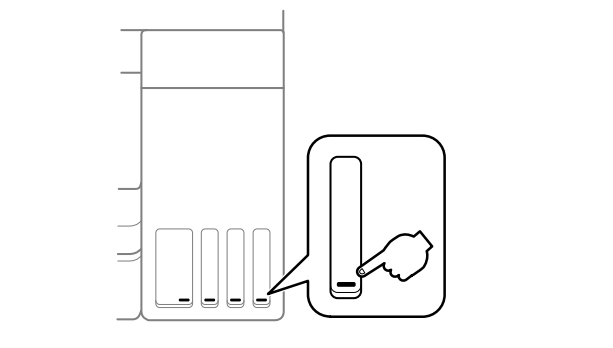
Note: The product has a low ink alert system. The accuracy of this system depends on the user refilling the ink tanks correctly. The product cannot directly measure the ink levels in the tanks; instead it estimates the amount of ink remaining by internally monitoring ink usage. The low ink alert system may generate inaccurate messages if the ink tanks are not refilled according to these instructions.
As a precaution, perform regular visual inspections of the ink tanks to ensure ink levels do not fall below the lower line. Continued use of the product when the ink level is below the lower line on the tank could damage the product.
Checking Ink Levels - Windows
A low ink reminder appears if you try to print when ink is low, and you can check your ink levels at any time using a utility on your Windows computer.
1. To check your ink levels, access the Windows Desktop and double-click the  icon for your product in the right side of the Windows taskbar, or click the up arrow and double-click
icon for your product in the right side of the Windows taskbar, or click the up arrow and double-click  .
.
You see a window like this:
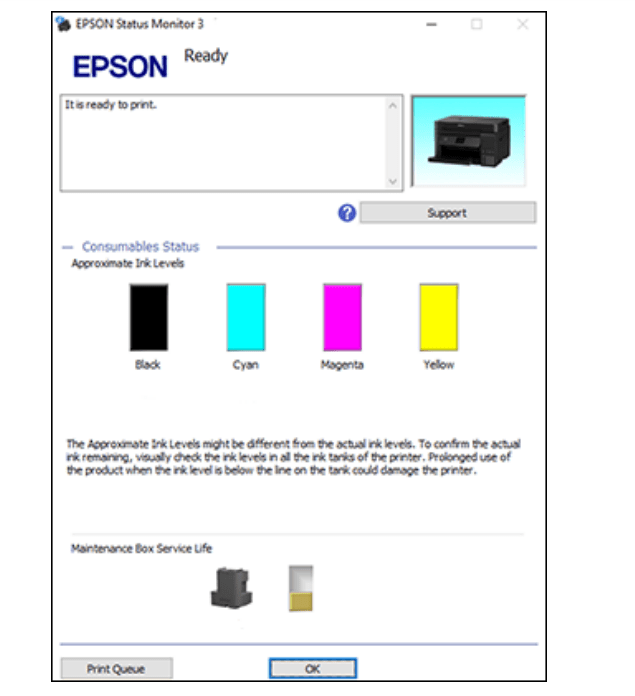
2. Refill any ink tank as needed.
Note: The ink levels displayed are an estimate and may differ from the actual ink remaining in the ink tanks. To confirm the actual remaining ink, visually check the ink levels in the ink tanks. Continued use of the product when the ink level is below the lower line on the tank could damage the product.
Checking Ink Levels - Mac
You can check your ink levels using a utility on your Mac.
1. In the Apple menu or the Dock, select System Preferences.
Select Print & Fax, Print & Scan, or Printers & Scanners, select your product, and select Options & Supplies. Select Utility and select Open Printer Utility.
2. Select EPSON Status Monitor.
You see a window like this:
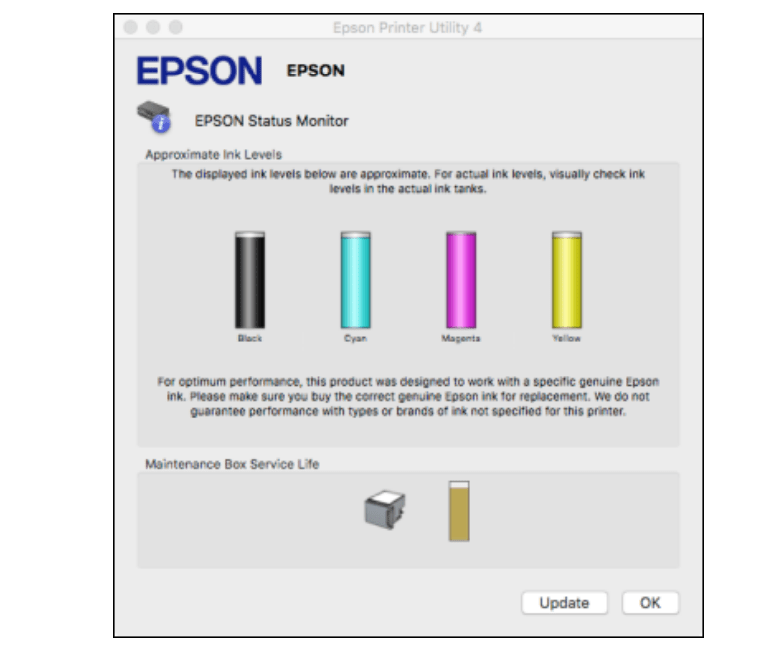
3. Refill any ink tank as needed.
Note: To update or refresh the displayed ink levels, click Update.
Note: The ink levels displayed are an estimate and may differ from the actual ink remaining in the ink tanks. To confirm the actual remaining ink, visually check the ink levels in the ink tanks. Continued use of the product when the ink level is below the lower line on the tank could damage the product.
Disabling Special Offers with Windows
You can disable special offers messages from Epson using a utility on your Windows computer.
1. Access the Windows Desktop and right-click the  icon for your product in the right side of the Windows taskbar, or click the up arrow and right-click
icon for your product in the right side of the Windows taskbar, or click the up arrow and right-click  . Select Monitoring Preferences.
. Select Monitoring Preferences.
You see this window:
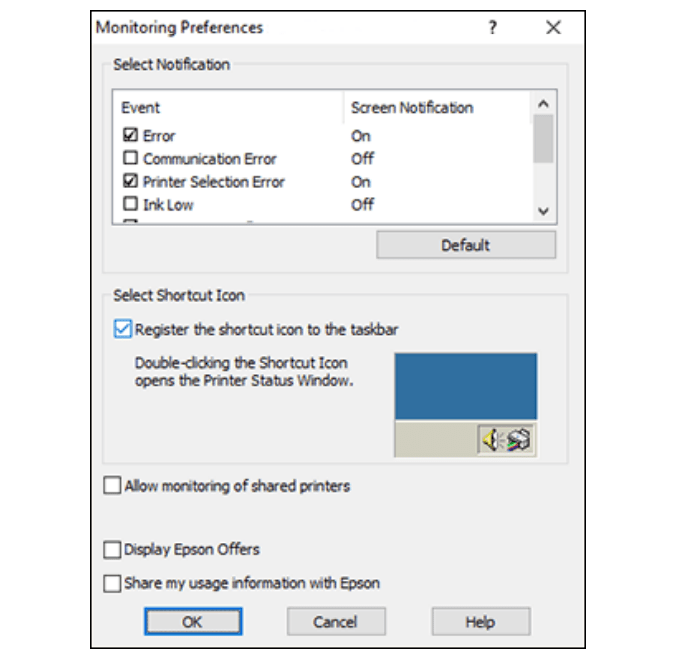
2. To disable promotional offers, deselect the Display Epson Offers checkbox.
Refilling the Ink Tanks
Make sure you have new ink bottles handy and have read the ink safety precautions before you begin. You can continue to use the product even if one or more ink tanks are not filled all the way. However, for the most accurate ink level monitoring, fill all the ink tanks up to the top line.
Note: The product has a low ink alert system. The accuracy of this system depends on the user refilling the ink tanks correctly. The product cannot directly measure the ink levels in the tanks; instead it estimates the amount of ink remaining by internally monitoring ink usage. The low ink alert system may generate inaccurate messages if the ink tanks are not refilled according to these instructions.
As a precaution, perform regular visual inspections of the ink tanks to ensure ink levels do not fall below the lower line. Continued use of the product when the ink level is below the lower line on the tank could damage the product.
Caution: Wear disposable gloves while refilling the ink tanks to avoid staining your hands. If ink spills, wipe it off immediately with a damp towel to avoid permanent stains. If ink gets on your clothes or belongings, it may not come off.
1. Turn on your product.
2. Lift up the scanner unit.
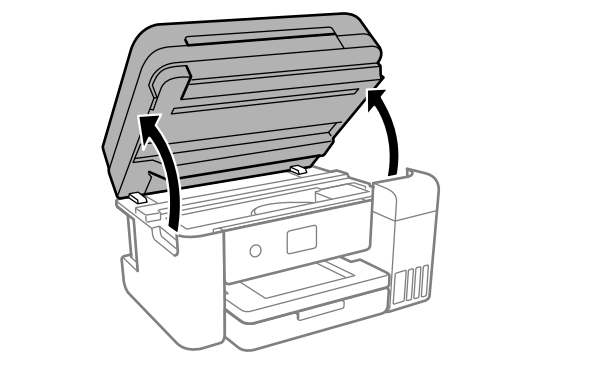
3. Open the ink tank cover, then open the cap for the ink tank you are going to fill.
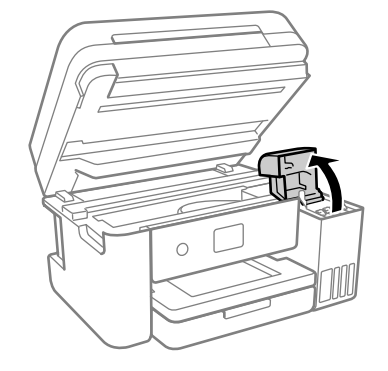
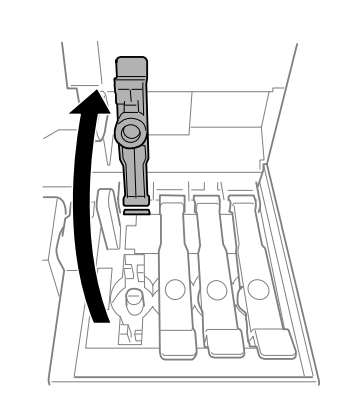
4. Hold the ink bottle upright and slowly turn the bottle cap to remove it.
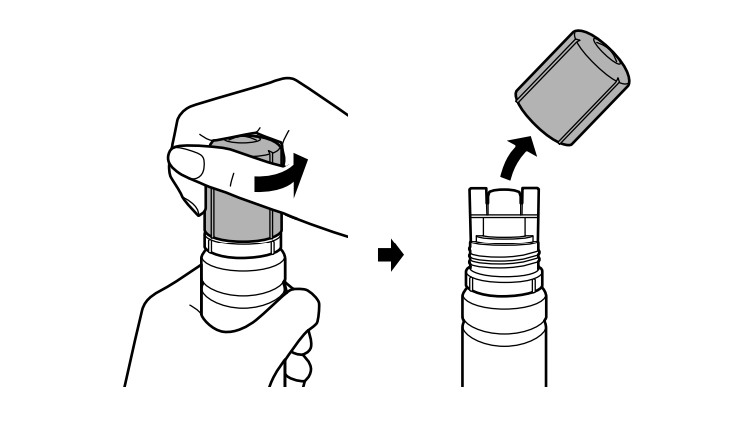
Caution: Do not shake or squeeze the bottle. Do not touch the top of the bottle after its cap is removed.
Warning: If ink gets on your skin, wash it thoroughly with soap and water. If ink gets into your eyes, flush them immediately with water. If ink gets into your mouth, spit it out immediately. Seek medical advice if problems persist. Keep the ink bottles out of the reach of children and do not drink the ink.
5. Position the top of the ink bottle along the slot in front of the filling port, then slowly stand the bottle up to insert it.
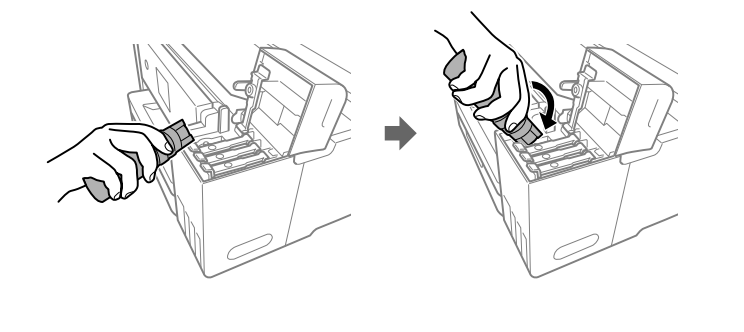
Note: Refer to the color-coded sticker on the ink tank unit to identify the color of each tank. Do not force the bottles into position; they are keyed for each color.
6. Wait for the ink to fill the tank. Do not squeeze the bottle. Ink flows into the tank and stops automatically when the ink is filled to the upper line.
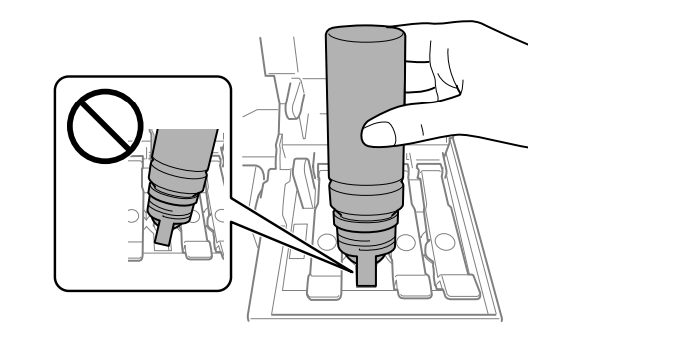
Note: If ink does not flow from the bottle, lift and reinsert the bottle.
7. When the ink tank is full, remove the ink bottle and securely close the ink tank cap.
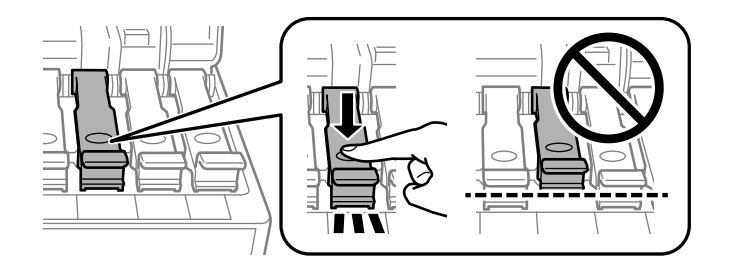
Note: If any ink remains in the bottle, replace the bottle cap and tighten it. Store the bottle upright for later use.
8. Repeat the previous steps as necessary for each ink tank you need to refill.
9. Close the ink tank cover, then close the scanner unit.
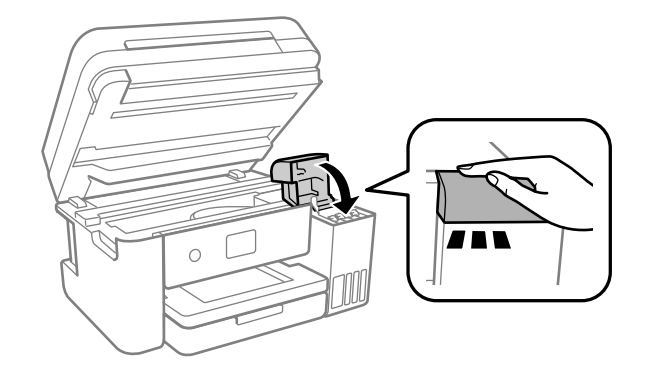
10. Follow the on-screen instructions to reset the ink level for the colors you refilled.
Maintenance Box Replacement
The maintenance box stores surplus ink that gets flushed from the system during print head cleaning. When you see a message on the LCD screen, follow the on-screen instructions to replace the maintenance box.
Note the following precautions when replacing the maintenance box:
- Do not remove the maintenance box or its cover except when replacing the maintenance box; otherwise, ink may leak.
- Do not touch the green chip on the side of the maintenance box.
- Do not tilt the maintenance box after removing it or ink may leak.
- Do not touch the openings in the maintenance box or you may get ink on you.
- Do not drop the maintenance box or subject it to strong shocks.
- If you cannot replace the cover, the maintenance box may not be installed correctly. Remove and reinstall the maintenance box.
- Do not store the maintenance box in high or freezing temperatures.
Caution: Do not reuse a maintenance box that has been removed and left uninstalled for a long period. Keep the maintenance box away from direct sunlight.
Note: The maintenance box is a user-replaceable part and is not covered by the product warranty.
Adjusting Print Quality
If your print quality declines, you may need to run a utility to clean or align the print head. If running these utilities does not solve the problem, you may need to run a Power Cleaning or clean the paper or print head path.
Print Head Maintenance
If your printouts become too light, or you see dark or light bands across them, you may need to clean the print head nozzles. Cleaning uses ink, so clean the nozzles only if print quality declines. You can check for clogged nozzles before you clean them so you don’t clean them unnecessarily.
Note: You cannot clean the print head if the ink level has reached the lower line on the ink tank, and may not be able to clean it when the ink level in any of the tanks is low.
You must refill the ink tank first. If you still see white or dark lines or gaps in your printouts, even after cleaning the print head several times, you can run a Power Cleaning.
Print Head Nozzle Check
You can print a nozzle check pattern to check for clogged nozzles.
Checking the Nozzles Using the Product Control Panel
You can check the print head nozzles using the control panel on your product.
1. Make sure there are no errors on the LCD screen and the output tray is extended.
2. Load a few sheets of plain paper in the product.
3. Press the home button, if necessary.
4. Select Maintenance and press the OK button.
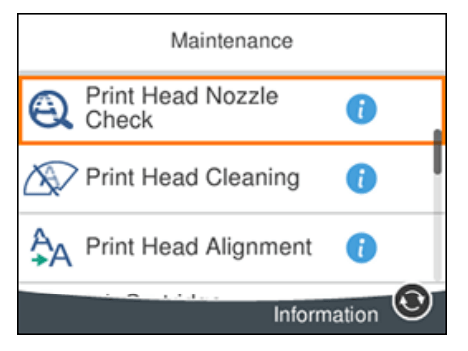
5. Press the OK button to select Print Head Nozzle Check.

6. Select Print and press the OK button. The nozzle check pattern is printed.
7. Check the printed pattern to see if there are gaps in the lines.
Print head is clean
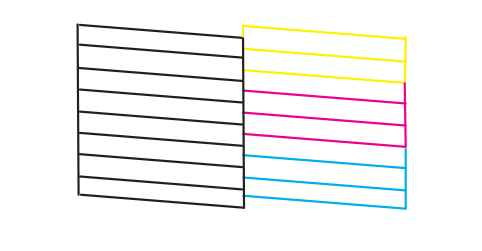
Print head needs cleaning
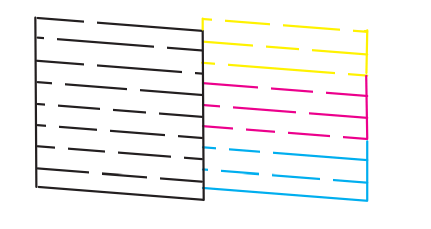
8. Do one of the following:
- If there are no gaps, the print head is clean. Press the OK button to select O.
- If there are gaps or the pattern is faint, press the right arrow button to select X. Follow the instructions on the screen to clean the print head.
If you don’t see any improvement after cleaning the print head up to 3 times, turn the product off and wait at least 12 hours. Then try cleaning the print head again. If quality still does not improve, run a Power Cleaning. If there is still no improvement, contact Epson support.
Checking the Nozzles Using a Computer Utility
You can check the print head nozzles using a utility on your Windows or Mac computer.
1. Make sure there are no errors on the LCD screen and the output tray is extended.
2. Load a few sheets of plain paper in the product.
3. Do one of the following:
- Windows: Access the Windows Desktop and right-click the
 icon for your product in the right side of the Windows taskbar, or click the up arrow and right-click
icon for your product in the right side of the Windows taskbar, or click the up arrow and right-click  .
. - Mac: In the Apple menu or the Dock, select System Preferences. Select Print & Fax, Print & Scan, or Printers & Scanners, select your product, and select Options & Supplies. Select Utility and select Open Printer Utility.
4. Select Nozzle Check. You see a window like this:
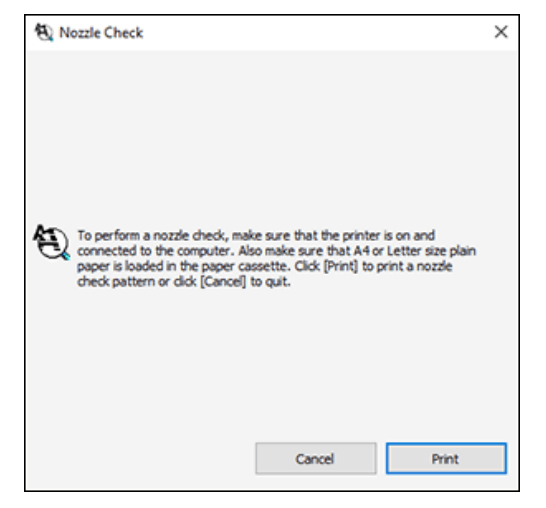
5. Click Print.
6. Check the printed pattern to see if there are gaps in the lines.
Print head is clean

Print head needs cleaning
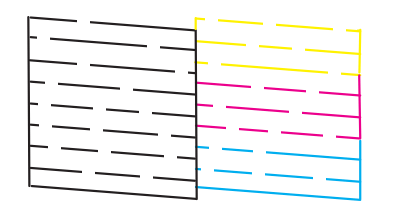
7. If there are no gaps, click Finish.
If there are gaps or the pattern is faint, clean the print head.
Print Head Cleaning
If print quality has declined and the nozzle check pattern indicates clogged nozzles, you can clean the print head.
Note: You cannot clean the print head if the ink level has reached the lower line on the ink tank, and may not be able to clean it when the ink level in any of the tanks is low. You must refill the ink tank first.
Cleaning the Print Head Using the Product Control Panel
You can clean the print head nozzles using the control panel on your product.
1. Make sure there are no errors on the LCD screen and the output tray is extended.
2. Load a few sheets of plain paper in the product.
3. Press the  home button, if necessary.
home button, if necessary.
4. Select Maintenance and press the OK button.

5. Select Print Head Cleaning and press the OK button.
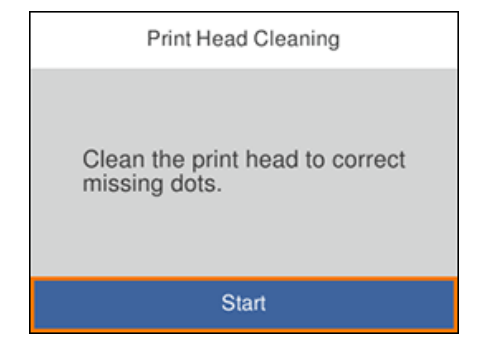
6. Press the OK button to clean the print head. You see a message on the LCD screen during the cleaning cycle.
Caution: Never turn off the product or open the printer cover during a cleaning cycle or you may not be able to print. When the cleaning cycle is finished, you see a message on the LCD screen.
7. Select Check and press the OK button.
8. Press the OK button to run a nozzle check and confirm that the print head is clean.
If you don’t see any improvement after cleaning the print head up to 3 times, turn off the product and wait at least 12 hours. Then try cleaning the print head again. If quality still does not improve, run a Power Cleaning. If there is still no improvement, contact Epson support.
Cleaning the Print Head Using a Computer Utility
You can clean the print head using a utility on your Windows or Mac computer.
1. Make sure there are no errors on the LCD screen and the output tray is extended.
2. Load a few sheets of plain paper in the product.
3. Do one of the following:
- Windows: Access the Windows Desktop and right-click the
 icon for your product in the right side of the Windows taskbar, or click the up arrow and right-click
icon for your product in the right side of the Windows taskbar, or click the up arrow and right-click  .
. - Mac: In the Apple menu or the Dock, select System Preferences. Select Print & Fax, Print & Scan, or Printers & Scanners, select your product, and select Options & Supplies. Select Utility and select Open Printer Utility.
4. Select Head Cleaning.
You see a window like this:

5. Click Start to begin the cleaning cycle.
The power light flashes throughout the cleaning cycle and stays on when the cleaning cycle is finished.
power light flashes throughout the cleaning cycle and stays on when the cleaning cycle is finished.
Caution: Never turn off the product or open the printer cover during a cleaning cycle or you may not be able to print.
6. When the cleaning cycle is finished, you can check to see if the nozzles are clean; click Print Nozzle Check Pattern and click Print.
7. Check the printed pattern to see if there are gaps in the lines.
Print head is clean
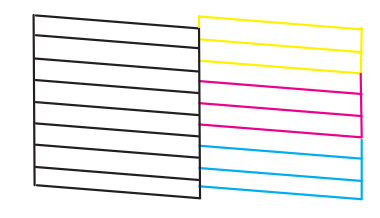
Print head needs cleaning
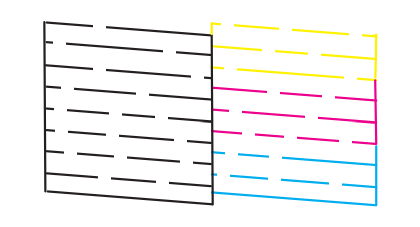
- If there are no gaps, click Finish.
- If there are gaps or the pattern is faint, click Clean to clean the print head again.
If you don’t see any improvement after cleaning the print head up to 3 times, turn off the product and wait at least 12 hours. Then try cleaning the print head again. If quality still does not improve, run a Power Cleaning. If there is still no improvement, contact Epson support.
Power Cleaning
If you still see white or dark lines or missing nozzles in your printouts, even after cleaning the print head several times, you can run a Power Cleaning. If you do not see improvement after running a Power Cleaning, turn off the product and wait at least 12 hours before running another Power Cleaning.
Caution: Running a Power Cleaning consumes a lot of ink, so you should run it only if necessary. Make sure each ink tank is at least one-third full before running a Power Cleaning, or it may damage the product.
Caution: Power Cleaning may cause the ink pads to reach their capacity sooner. When an ink pad reaches the end of its service life, the product stops printing and you must contact Epson for support.
Power Cleaning Using the Product Control Panel
You can run a Power Cleaning using the control panel on your product.
After a Power Cleaning, you must turn off the product and wait at least 12 hours before running another Power Cleaning.
- Turn off the product.
- Visually check the ink levels and make sure each ink tank is at least one-third full.
- Caution: If you run a Power Cleaning when the ink levels are low, you may damage the product.
- Press and hold the
 power button and the
power button and the  help button at the same time until the Power Cleaning screen appears on the LCD screen.
help button at the same time until the Power Cleaning screen appears on the LCD screen. - Follow the on-screen instructions to run the Power Cleaning
- When the Power Cleaning is finished, run a nozzle check.
If the print quality did not improve, turn off the printer and wait at least 12 hours before running another Power Cleaning. If the print quality does not improve after running the Power Cleaning utility multiple times, contact Epson for support.
Power Cleaning Using a Computer Utility
You can run a Power Cleaning using a utility on your Windows or Mac computer.
Note: After running a Power Cleaning, you must turn off the product and wait at least 12 hours before running another Power Cleaning.
1. Make sure there are no errors on the LCD screen and the output tray is extended.
2. Load a few sheets of plain paper in the product.
3. Do one of the following:
- Windows: Access the Windows Desktop and right-click the
 icon for your product in the right side of the Windows taskbar, or click the up arrow and right-click
icon for your product in the right side of the Windows taskbar, or click the up arrow and right-click  . Select Printer Settings and click the Maintenance tab.
. Select Printer Settings and click the Maintenance tab. - Mac: In the Apple menu or the Dock, select System Preferences. Select Print & Fax, Print & Scan, or Printers & Scanners, select your product, and select Options & Supplies. Select Utility and select Open Printer Utility.
4. Select Power Cleaning.
You see a window like this:
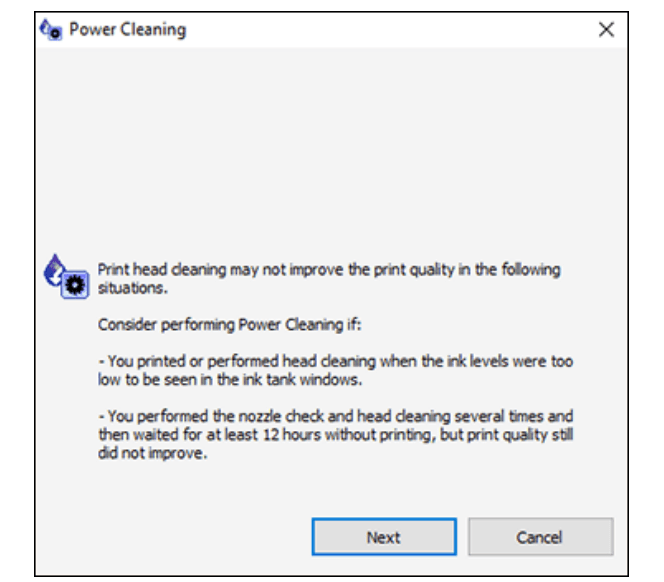
5. Follow the on-screen instructions to run a Power Cleaning.
6. When Power Cleaning is finished, run a nozzle check.
If the print quality did not improve, turn off the product and wait at least 12 hours before running another Power Cleaning. If the print quality does not improve after running the Power Cleaning utility multiple times, contact Epson for support.
Print Head Alignment
If your printouts become grainy or blurry, you notice misalignment of vertical lines, or you see dark or light horizontal bands, you may need to align the print head.
Note: Banding may also occur if your print head nozzles need cleaning
Aligning the Print Head Using the Product Control Panel
You can align the print head using the control panel on your product.
1. Make sure there are no errors on the LCD screen and the output tray is extended.
2. Load a few sheets of plain paper in the product.
3. Press the  home button, if necessary.
home button, if necessary.
4. Select Maintenance and press the OK button.
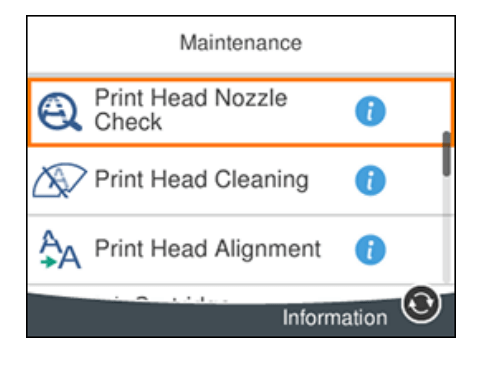
5. Select Print Head Alignment and press the OK button.
6. Do one of the following:
- Select Ruled Line Alignment and press the OK button.
- Select Vertical Alignment and press the OK button.
- Select Horizontal Alignment and press the OK button.
7. Press the OK button to print an alignment sheet.
- Note: Do not cancel printing while you are printing a head alignment pattern.
8. Check the printed pattern and select the number representing the most solid printed pattern for each set on the LCD screen.
Ruled Line Alignment
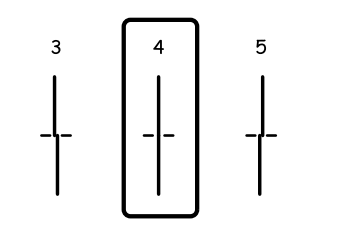
Vertical Alignment

Horizontal Alignment
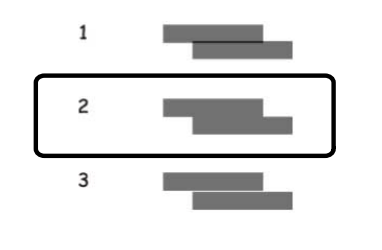
9. Press the OK button when you are finished.
Cleaning the Paper Guide
If you see ink on the back of a printout, you can clean the paper guide rollers to remove any excess ink.
1. If printouts are smeared or scuffed, load plain paper in the cassette in this size: Letter (8.5 × 11 inches [216 × 279 mm]) or A4 (8.3 × 11.7 inches [210 × 297 mm]).
2. Select Maintenance.
You see a screen like this:
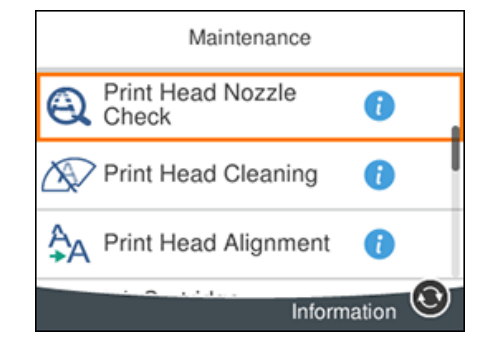
3. Scroll down and select Paper Guide Cleaning.
4. Follow the on-screen instructions to clean the paper guide.
5. Repeat these steps as necessary until the paper comes out clean.
Cleaning the Print Head Path
If the print quality has not improved after cleaning and aligning the print head and cleaning the paper path, the print head path inside the printer may be smeared with ink. To clean the print head path, use the following:
- Several cotton swabs
- ¼ cup (59 ml) water containing 2 to 3 drops of mild dish detergent
- A small flashlight
Caution: Do not use any other liquid to clean the print head path or you may damage your product.
1. Turn off the product.
2. Unplug the power cable.
3. Disconnect any connected cables.
4. Lift up the scanner unit.
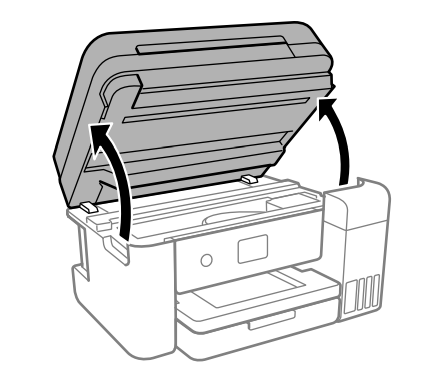
5. Using the flashlight, check the translucent film shown here for ink smears.
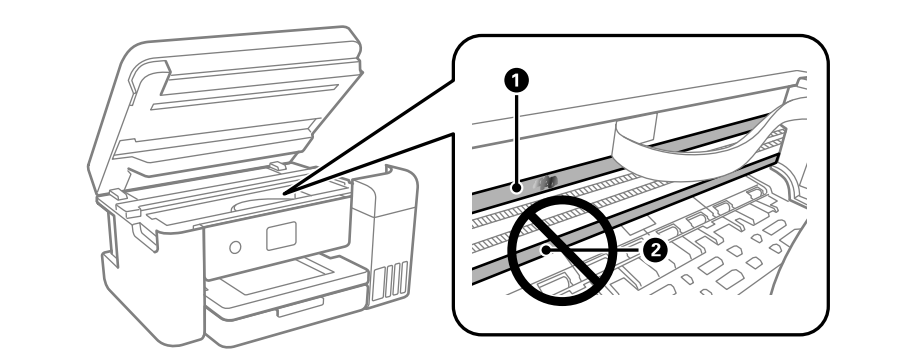
- Translucent film
- Print head rail
Caution: Do not touch the print head rail or wipe the grease off of it. You may not be able to print.
6. Moisten a cotton swab with the water and detergent mixture, and squeeze out any excess moisture. Lightly wipe the ink off the translucent film.

Caution: Do not press too hard on the film or you may dislocate the anchor springs and damage your product.
7. Use a new, dry cotton swab to dry the translucent film.
8. Repeat steps 6 and 7 as necessary to clean all ink smears.
9. When the translucent film is dry, close the scanner unit.
10. Reconnect any disconnected cables, plug in the power cord, and turn on the product.
Checking the Number of Sheets
You can view an option that displays the number of sheets of paper that have fed through the product.
Note: You can also view the number of sheets of paper fed through the product by printing a nozzle check.
Checking the Sheet Counter - Windows
You can check the number of sheets of paper that have fed through the product by checking the sheet counter.
1. Access the Windows Desktop and right-click the  icon for your product in the right side of the Windows taskbar, or click the up arrow and right-click
icon for your product in the right side of the Windows taskbar, or click the up arrow and right-click  .
.
2. Select Printer Settings.
3. Click the Maintenance tab.
4. Select Printer and Option Information.
You see this window:

5. After checking the number of sheets fed into the printer, click OK to close the window.
Note: The number of sheets is displayed only when Epson Status Monitor 3 is enabled.
Checking the Sheet Counter - Mac
You can check the number of sheets of paper that have fed through the product by checking the sheet counter.
1. In the Apple menu or the Dock, select System Preferences. Select Print & Fax, Print & Scan, or Printers & Scanners, select your product, and select Options & Supplies. Select Utility and select Open Printer Utility.
2. Select Printer and Option Information.
You see this window:
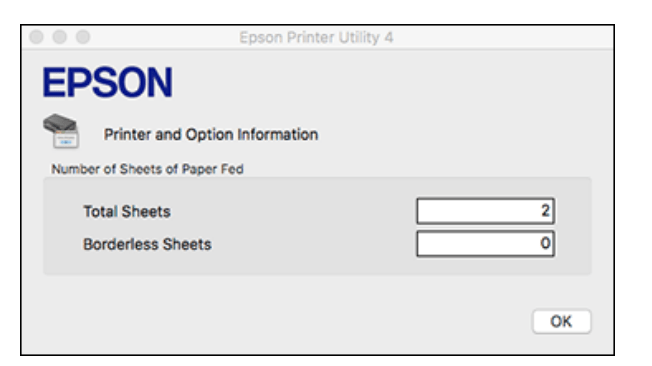
3. After checking the number of sheets fed into the printer, click OK to close the window.
Cleaning and Transporting Your Product
Cleaning Your Product
To keep your product working at its best, you should clean it several times a year. Close the output tray and front cover when you are not using the product to protect it from dust.
Caution: Do not use a hard brush, alcohol, or paint thinner to clean the product or you may damage it. Do not use oil or other lubricants inside the product or let water get inside it.
- Turn off the product.
- Unplug the power cable.
- Disconnect any connected cables.
- Remove all the paper.
- Clean the scanner glass with a soft, lint-free cloth (microfiber is recommended), moistened with a little glass cleaner.
- Caution: Do not spray glass cleaner directly on the glass and do not press the glass surface with any force.
- Clean the outer case and control panel with a soft, dry cloth. Do not use liquid or chemical cleansers
Cleaning the Paper Rollers
If you encounter repeated paper feed issues from the cassette, clean the paper rollers inside the product.
1. Turn off the product.
2. Unplug the power cable.
3. Disconnect any connected cables.
4. Slide out the paper cassette and remove the paper.
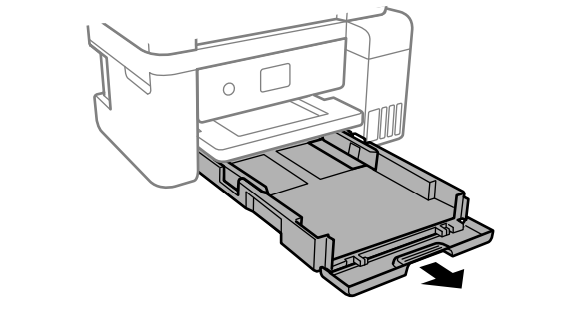
5. Make sure the ink tank caps are securely closed.

6. Place the product on its side with the ink tank on the bottom.
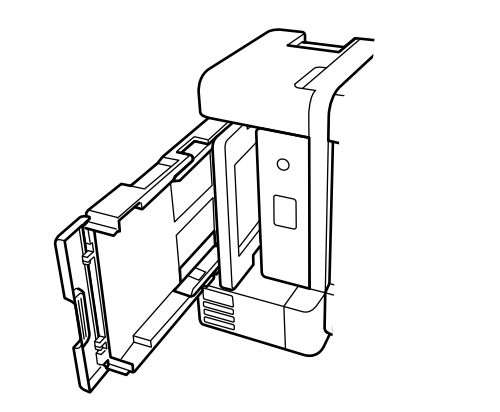
Warning: Be careful not to trap your fingers under the product.
7. Use a soft, moist cloth to clean the paper rollers, as shown. Rotate the rollers to clean them thoroughly.

8. Return the product to its normal position.
- Caution: Do not leave the printer on its side for an extended period of time.
9. Replace the paper, slide in the paper cassette, and connect the power cord.
Transporting Your Product
If you need to store your product or transport it some distance, prepare it for transportation as described here.
Caution: During transportation and storage, follow these guidelines:
- Avoid tilting the product, placing it vertically, or turning it upside down; otherwise ink may leak.

- When storing or transporting an ink bottle after it has been opened, do not tilt the bottle and do not subject it to impacts or temperature changes. Otherwise, ink may leak even if the cap on the ink bottle is tightened securely. Be sure to keep the ink bottle upright when tightening the cap, and take measures to prevent ink from leaking when transporting the ink bottles.
- Do not put opened ink bottles in the box with the product.
- Do not carry the product by its control panel; this may damage the product.
1. Turn off the product.
2. Remove all the paper from the product.
3. Unplug the power cable.
4. Disconnect any connected cables.
5. Lift up the scanner unit and check to see if the print head is in the far right position (the home position). If not, turn on the product, wait for the print head to move to the far right, then turn the product off again.
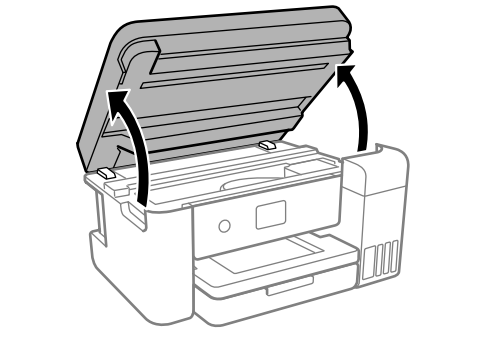
6. Secure the print head to the case with tape.
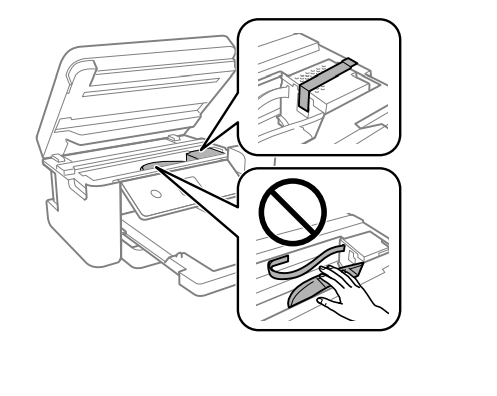
Caution: Do not place tape on the white flat cable inside the product; otherwise, you may damage your product.
7. Make sure the ink tank caps are securely closed and close the ink tank cover.
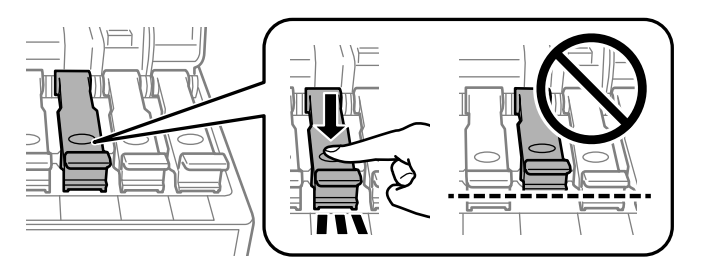
8. Lower the scanner unit.

9. Slide in the output tray and close the front cover, then lower the control panel.
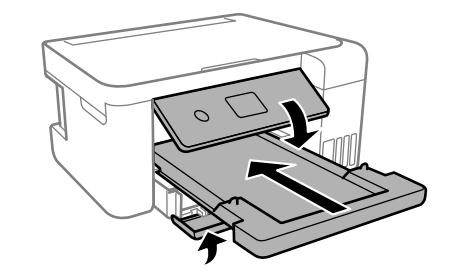
10. Place the product in its original packaging materials, if possible, or use equivalent cushioning around the product.
Be sure to remove the tape from the print head before turning on your product. If print quality has declined when you print again, clean and align the print head.
Troubleshooting
Checking for Software Updates
It's a good idea to check Epson's support website occasionally for free updates to your product software. Visit epson.com/support (U.S.), epson.ca/support (Canada), or epson.com.jm/support (Caribbean) and select your product.
- Windows: Your printer software automatically checks for updates. You can also manually update the software by selecting Software Update here:
- Accessing the Windows Desktop and right-clicking the
 icon for your product in the right side of the Windows taskbar, or clicking the up arrow and right-clicking
icon for your product in the right side of the Windows taskbar, or clicking the up arrow and right-clicking  .
. - On the Maintenance tab in the printer settings window
- Accessing the Windows Desktop and right-clicking the
You can also update the software by selecting EPSON Software Updater in the EPSON or EPSON Software program group, accessible by the Start button, or on the Start or Apps screens, depending on your version of Windows.
- OS X: You can manually update the software by opening the Applications > Epson Software folder and selecting EPSON Software Updater.
- macOS 10.12.x or later: You can manually update the software by opening the App Store, selecting Updates, searching for a software update option for Epson Software, and selecting Update.
Product Status Messages
You can often diagnose problems with your product by checking the messages on its LCD screen. You can also see help information and how-to instructions on the screen. Press the  home button, if necessary, and select the
home button, if necessary, and select the  help button.
help button.
LCD screen message | Condition/solution |
| Printer error. Turn on the printer again. See your documentation for details. | A fatal error has occurred. Turn the product off and then back on again. If the error continues, check for a paper jam. If there is no paper jam, contact Epson for support. |
| Paper out in XX. | Load paper in the specified cassette |
| Paper Setup Auto Display is set to Off. Some features may not be available. For details, see your documentation | The Paper Setup Auto Display setting must be turned on to use AirPrint. |
| The printer's borderless printing ink pad is nearing the end of its service life. It is not a user-replaceable part. Please contact Epson support. | The ink pad is near the end of its service life and the message will be displayed until the ink pad is replaced. Contact Epson for support. (To resume printing, select Dismiss.) |
| The printer's borderless printing ink pad has reached the end of its service life. It is not a user-replaceable part. Please contact Epson support. | The ink pad is at the end of its service life. Turn off the product and contact Epson for support. You can still perform operations that do not use ink, such as scanning |
| To use cloud services, update the root certificate from the Epson Web Config utility. | Access your product's built-in Web Config utility and update the root certificate for your product. |
| The combination of the IP address and the subnet mask is invalid. See your documentation for more details. | There is a problem with the network connection to your product. Check the solutions in this guide. |
| Make sure the printer port is selected correctly on the Port tab of the Printer Properties screen (Windows) or the System Properties > USB list (Mac). Select USBXXX for a USB connection or EpsonNet Print Port for a network connection. |
| Recovery mode | An error has occurred during firmware updating. Connect your product using a USB cable and try updating the firmware again. If you still receive this error message, contact Epson for support. |
Note: The ink pads in the printer collect, distribute, and contain the ink that is not used on printed pages. During the life of your product it may reach a condition where either satisfactory print quality cannot be maintained or the ink pads have reached the end of their usable life. The Epson Status Monitor, your LCD screen, or lights on the control panel will advise you when these parts need replacing. If this happens during the standard warranty of the product, the exchange of the product or replacement of the pads is covered under the standard warranty. If the product is out of warranty, the pads can be replaced by any Epson authorized service provider. The waste ink pads are not a user-replaceable part.
Message Appears Prompting You to Reset Ink Levels
If you see a message on the LCD screen prompting you to reset the ink levels, do the following:
- Refill all of the ink tanks or the ink tanks indicated on the LCD screen all the way to the top. Note: Depending on the operating conditions, you may see the ink reset message even when there is still ink in the tanks.
- Select the colors that you refilled on the LCD screen.
- Follow the instructions on the LCD screen to reset the ink levels.
Note: The product has a low ink alert system. The accuracy of this system depends on the user refilling the ink tanks correctly. The product cannot directly measure the ink levels in the tanks; instead it estimates the amount of ink remaining by internally monitoring ink usage. The low ink alert system may generate inaccurate messages if the ink tanks are not refilled according to these instructions. As a precaution, perform regular visual inspections of the ink tanks to ensure ink levels do not fall below the lower line. Continued use of the product when the ink level is below the lower line on the tank could damage the product.
Running a Product Check
Running a product check helps you determine if your product is operating properly.
1. Disconnect any interface cables connected to your product.
2. Load plain paper in the product.
3. Press the home button, if necessary.
4. Select Maintenance and press the OK button
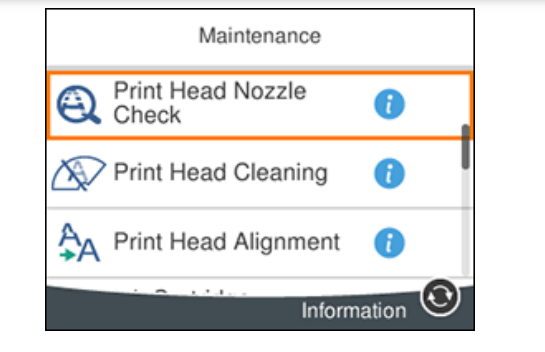
5. Select Print Head Nozzle Check and press the OK button.

6. Press the OK button.
The nozzle check pattern is printed.
7. Do one of the following, depending on the results of the product check:
- If the page prints and the nozzle check pattern is complete, the product is operating properly. Any operation problem you may have could be caused by your computer, cable, software, or selected settings. Check the other solutions in this book or try uninstalling and reinstalling your printer software.
- If the page prints but the nozzle check pattern has gaps, clean or align the print head.
- If the page does not print, the product may have a problem. Check the other solutions in this manual. If they do not work, contact Epson.
Resetting Control Panel Defaults
If you have a problem with settings on the product control panel, you can reset them to their factory defaults. You can choose which settings to reset or reset them all.
1. Press the  home button, if necessary.
home button, if necessary.
2. Press the arrow buttons to select Settings and press the OK button.
3. Select Restore Default Settings and press the OK button.

4. Select one of these options:
- Network Settings: Resets all network settings.
- Copy Settings: Resets all copy settings.
- Scan Settings: Resets all scan settings.
- Clear All Data and Settings: Resets all control panel settings and any stored information. You see a confirmation screen.
5. Select Yes to reset the selected settings. (Select No if you want to cancel the operation.)
Solving Setup Problems
Noise After Filling the Ink
If you hear noises from your product after filling the ink tanks with ink, check these explanations:
- The first time you fill the tanks with ink, the product must charge its print head. Wait until charging finishes before you turn off the product, or it may charge improperly and use excess ink the next time you turn it on. Your product is finished charging the print head when the
 power light stops flashing.
power light stops flashing. - If the product's print head stops moving or making noise, and the charging process has not finished after approximately 20 minutes, turn off your product. Turn it back on and check to see if charging is still in progress. If it is still in progress, contact Epson for help.
Software Installation Problems
If you have problems while installing your product software, try these solutions:
- Make sure your product is turned on and any necessary cables are securely connected at both ends. If you still have problems installing software, disconnect the cable and carefully follow the instructions on the Start Here sheet. Also make sure your system meets the requirements for your operating system.
- Close any other programs, including screen savers and virus protection software, and install your product software again.
- In Windows, make sure your product is selected as the default printer and the correct port is shown in the printer properties.
- If you see any error message or your software does not install correctly in Windows, you may not have software installation privileges. Contact your system administrator.
Control Panel Setup Problems
If you have problems setting up the control panel, try these solutions:
- To view LCD screen text in a different language, select a different language setting for the panel.
- To adjust the position of the control panel, carefully raise or lower it.
Solving Network Problems
Product Cannot Connect to a Wireless Router or Access Point
If your product has trouble finding or connecting to a wireless router or access point, try these solutions:
- If you are connecting the product via Wi-Fi Protected Setup (WPS) and the Wi-Fi icon on your product's LCD screen is not lit or does not appear, make sure you select one of the WPS options from the product control panel within 2 minutes of pressing the WPS button on your router.
- Make sure to place your product within contact range of your 2.4 GHz router or access point. Avoid placing your product near a microwave oven, 2.4 GHz cordless phone, or large metal object, such as a filing cabinet.
Note: If you are using a 5 GHz wireless router, set the router to operate in dual band (2.4 GHz and 5 GHz) mode. If your router uses a single network name (SSID) for both the 2.4 GHz and 5 GHz band, give each band its own network name (SSID) instead, such as Home Network 2.4 GHz and Home Network 5 GHz. See your router documentation or contact your internet service provider for instructions.
- Verify that your router or access point is operating correctly by connecting to it from your computer or another device.
- Print a network connection report and check the codes and messages on the report to help determine the cause of the problem.
- You may need to disable the firewall and any anti-virus software on your wireless router or access point.
- Try restarting your router following the instructions in your router documentation.
- Note: If you are reading these instructions online, you will lose your Internet connection when you restart your router.
- Check to see if access restrictions, such as MAC address filtering, are set on the router or access point. If access restrictions are set, add your product's MAC address to your router's address list. To obtain your product's MAC address, print a network status sheet. Then follow the instructions in your router or access point documentation to add the address to the list.
- If your router or access point does not broadcast its network name (SSID), follow the instructions that came with your product to enter your wireless network name manually.
- If your router or access point has security enabled, determine the kind of security it is using and any required password or passphrase for connection. Then make sure to enter the exact WEP key or WPA passphrase correctly.
- Check if your computer is restricting the available wireless channels. If so, verify that your wireless access point is using one of the usable channels and change to a usable channel, if necessary.
- If you are using a Wi-Fi Direct connection that suddenly disconnects, the Wi-Fi direct password on your device may have been changed. If necessary, delete the existing DIRECT-xxxxxxxx connection settings from your device and enter a new password. See your device documentation for instructions.
- If you connected your product to a Windows computer using Wi-Fi Direct and it automatically selected Access Point Mode, you may have trouble accessing a low-priority Internet connection. Check the network connection or adapter settings in the Windows Control Panel and set the Internet metric setting to 100 for your version of the Internet Protocol.
Network Software Cannot Find Product on a Network
If EpsonNet Setup cannot find your product on a network, try these solutions:
- Make sure your product is turned on and connected to your network. Verify the connection using your product control panel.
- Check if your network name (SSID) contains non-ASCII characters. Your product cannot display nonASCII characters.
- Print a network connection report and check the codes and messages on the report to help determine the cause of the problem.
- Make sure your product is not connected to a guest network.
- If necessary, reinstall your product software and try running EpsonNet Setup again:
- Reset your product's network settings to their factory defaults.
- Windows only: Uninstall your product software.
- Restart your router following the instructions in your router documentation.
- Note: If you are reading these instructions online, you will lose your Internet connection when you restart your router, so note the next step before restarting it.
- Download your product software from the Epson website using the instructions on the Start Here sheet.
- If you have replaced your router, reinstall your product software to connect to the new router.
- Note: If you are using a 5 GHz wireless router, set the router to operate in dual band (2.4 GHz and 5 GHz) mode. If your router uses a single network name (SSID) for both the 2.4 GHz and 5 GHz band, give each band its own network name (SSID) instead, such as Home Network 2.4 GHz and Home Network 5 GHz. See your router documentation or contact your internet service provider for instructions.
- Check to see if your wireless router or access point has an enabled Privacy Separator function that is preventing detection of your device over the network. See your router or access point documentation for instructions on disabling the Privacy Separator function.
Product Does Not Appear in Mac Printer Window
If your product does not appear in the Mac printer window, try these solutions:
- Turn your product off, wait 30 seconds, then turn it back on again.
- If you are connecting the product via Wi-Fi Protected Setup (WPS) and the Wi-Fi icon on your product's LCD screen is not lit, make sure you select one of the WPS options from the product control panel within 2 minutes of pressing the WPS button on your router.
- If you are connecting the product wirelessly via EpsonNet Setup and the Wi-Fi icon does not appear lit on your LCD screen, make sure your product software was installed correctly. If necessary, reinstall your software.
Note: If you are using a 5 GHz wireless router, set the router to operate in dual band (2.4 GHz and 5 GHz) mode. If your router uses a single network name (SSID) for both the 2.4 GHz and 5 GHz band, give each band its own network name (SSID) instead, such as Home Network 2.4 GHz and Home Network 5 GHz. See your router documentation or contact your internet service provider for instructions.
Wireless Network Connection is Unstable on a Mac
If you connected a device to a USB 3.0 port on your Mac, you may experience wireless network interference between your product and your Mac. If you cannot connect to your product over the wireless network or the connection becomes unstable, move the device connected to your Mac USB 3.0 port further away from your Mac.
Cannot Print Over a Network
If you cannot print over a network, try these solutions:
- Make sure that your product is turned on.
- Make sure you install your product's network software as described in your product documentation.
- Print a network status sheet and verify that the network settings are correct. If the network status is Disconnected, check any cable connections and turn your product off and then on again.
- Print a network connection report and check the codes and messages on the report to help determine the cause of the problem.
- If you are using TCP/IP, make sure the product's IP address is set correctly for your network. If your network does not assign IP addresses using DHCP, set the IP address manually.
- Make sure your computer and product are both using the same wireless network.
- If network printing is slow, print a network status sheet and check the signal strength. If it is poor, place your product closer to your router or access point. Avoid placing your product near a microwave oven, 2.4 GHz cordless phone, or large metal object, such as a filing cabinet.
Note: If you are using a 5 GHz wireless router, set the router to operate in dual band (2.4 GHz and 5 GHz) mode. If your router uses a single network name (SSID) for both the 2.4 GHz and 5 GHz band, give each band its own network name (SSID) instead, such as Home Network 2.4 GHz and Home Network 5 GHz. See your router documentation or contact your internet service provider for instructions.
- Try restarting your router following the instructions in your router documentation.
Note: If you are reading these instructions online, you will lose your Internet connection when you restart your router.
- Check to see if your wireless router or access point has an enabled Privacy Separator function that is preventing printing from a device over the network. See your router or access point documentation for instructions on disabling the Privacy Separator function.
- If you are connecting the product wirelessly via EpsonNet Setup and the Wi-Fi connection icon is not lit or does not appear on the product's LCD screen, make sure your product software was installed correctly. If necessary, reinstall your software.
Cannot Scan Over a Network
If you cannot start Epson Scan 2 for scanning over a network, try these solutions:
- If you cannot scan from your product control panel, make sure you restarted your computer after installing the product software. Make sure the Event Manager program is not being blocked by your firewall or security software.
Note: If you are using a 5 GHz wireless router, set the router to operate in dual band (2.4 GHz and 5 GHz) mode. If your router uses a single network name (SSID) for both the 2.4 GHz and 5 GHz band, give each band its own network name (SSID) instead, such as Home Network 2.4 GHz and Home Network 5 GHz. See your router documentation or contact your internet service provider for instructions.
- If you are scanning a large original at a high resolution, a network communication error may occur. Try scanning again at a lower resolution.
- If network communication was interrupted while starting Epson Scan 2, exit Epson Scan 2, wait a few seconds, and restart it. If Epson Scan 2 cannot restart, turn off your product, turn it back on, and try restarting Epson Scan 2 again.
- Check the scanner setting and reset the connection if necessary using Epson Scan 2 Utility:
Windows 10: Click  and select EPSON > Epson Scan 2 Utility. Make sure your product is selected. If necessary, select the Other tab and click Reset.
and select EPSON > Epson Scan 2 Utility. Make sure your product is selected. If necessary, select the Other tab and click Reset.
Windows 8.x: Navigate to the Apps screen, select EPSON, and select Epson Scan 2 Utility. Make sure your product is selected. If necessary, select the Other tab and click Reset.
- Windows (other versions): Click
 or Start > All Programs or Programs > EPSON > Epson Scan 2 > Epson Scan 2 Utility. Make sure your product is selected. If necessary, select the Other tab and click Reset.
or Start > All Programs or Programs > EPSON > Epson Scan 2 > Epson Scan 2 Utility. Make sure your product is selected. If necessary, select the Other tab and click Reset.
Mac: Open the Applications folder, click Epson Software, and click Epson Scan 2 Utility. Make sure your product is selected. If necessary, select the Other tab and click Reset.
- You may need to disable the firewall and any anti-virus software on your wireless router or access point.
Solving Copying Problems
Product Makes Noise, But Nothing Copies
If your product makes a noise, but nothing copies, try these solutions:
- Run a nozzle check to see if any of the print head nozzles are clogged. Then clean the print head, if necessary.
- If the nozzle check page does not print, but the product's power is on, make sure your product software is installed correctly.
- Make sure your product is level (not tilted)
Product Makes Noise When It Sits for a While
Your product is performing routine maintenance. This is normal.
Solving Paper Problems
Paper Feeding Problems
If you have problems feeding paper, try these solutions:
- Make sure the paper cassette is inserted all the way in the printer.
- If paper does not feed correctly, remove and reload it in the cassette and adjust the edge guides. Make sure the paper stack is not above the tab on the edge guides inside the cassette.
- If multiple pages feed at once, remove the paper, fan the edges to separate the sheets, and reload it.
- Do not load more than the recommended number of sheets.
- Make sure your paper meets the specifications for your product.
- If paper jams when you print on both sides of the paper, try loading fewer sheets.
- For best results, follow these guidelines:
- Use new, smooth, high-quality paper that is not curled, creased, old, too thin, or too thick.
- Load paper in the cassette printable side down.
- Follow any special loading instructions that came with the paper.
Paper Jams Inside the Product
If you see a message that paper has jammed in the product, follow the on-screen instructions to locate and remove the jammed paper. Take the following precautions when removing jammed paper from the product:
- Remove the jammed paper carefully. Using too much force may damage the product.
- Unless specifically instructed, avoid tilting the product, placing it on its side, or turning it upside down, as ink may spill.
Warning: Never touch the buttons on the control panel while your hand is inside the product. If the product starts operating, it may cause an injury. Do not touch any protruding parts inside the product.
Paper Ejection Problems
If you have problems with paper ejecting properly, try these solutions:
- If paper does not eject fully, you may have set the wrong paper size. Cancel printing to eject the paper. Select the correct paper size when you reprint.
- If paper is wrinkled when it ejects, it may be damp or too thin. Load new paper and be sure to select the correct paper type setting when you reprint.
Solving Problems Printing from a Computer
Nothing Prints
If you have sent a print job and nothing prints, try these solutions:
- Make sure your product is turned on and connected to your computer.
- Make sure any interface cables are connected securely at both ends.
- If you connected your product to a USB hub, make sure it is a first-tier hub. If it still does not print, connect your product directly to your computer instead of the hub
- Make sure the printer status is not offline or pending.
- Run a product check to see if a test page prints. If the test page prints, check to see if your product software is installed correctly.
- Make sure your system meets the requirements for your operating system. If you are printing a highresolution image, you may need more than the minimum requirements. Print the image at a lower resolution or if necessary, increase your system's memory.
- In Windows, make sure your product is selected as the default printer and the printer port setting matches the printer connection port.
- In Windows, delete all jobs from the Windows Spooler. Click Print Queue on the Maintenance tab in the printer settings window, and cancel any stalled print jobs.
- On a Mac, make sure the printer is added to the printer list and the printer is not paused.
Product Icon Does Not Appear in Windows Taskbar
If you do not see your product icon in the Windows taskbar, first try restarting your computer. If that does not work, try this solution:
- Do one of the following:
- Windows 10: Click
 and select
and select  (Settings) > Devices > Printers & scanners. Select your product name and select Manage > Printing preferences.
(Settings) > Devices > Printers & scanners. Select your product name and select Manage > Printing preferences. - Windows 8.x: Navigate to the Apps screen and select Control Panel > Hardware and Sound > Devices and Printers. Right-click your product name, select Printing Preferences, and select your product name again if necessary.
- Windows 7: Click
 and select Devices and Printers. Right-click your product name, select Printing Preferences, and select your product name again if necessary.
and select Devices and Printers. Right-click your product name, select Printing Preferences, and select your product name again if necessary. - Windows Vista: Click
 , select Control Panel, and click Printer under Hardware and Sound. Right-click your product name, select Printing Preferences, and select your product name again if necessary.
, select Control Panel, and click Printer under Hardware and Sound. Right-click your product name, select Printing Preferences, and select your product name again if necessary.
- Windows 10: Click
- Click the Maintenance tab.
- Click the Extended Settings button.
- Select Enable EPSON Status Monitor 3 and click OK.
- Click the Monitoring Preferences button.
- Click the checkbox for the option that adds the shortcut icon to the taskbar.
- Click OK to close the open program windows
Printing is Slow
If printing becomes slow, try these solutions:
- Make sure your system meets the requirements for your operating system. If you are printing a high-resolution image, you may need more than the minimum requirements. If necessary, increase your system's memory.
- If you are using Windows 7, close the Devices and Printers window before you print.
- On a Mac, make sure you download and install the Epson printer driver.
- Make sure Quiet Mode is turned off.
- Clear space on your hard drive or run a defragmentation utility to free up existing space.
- Close any programs you are not using when you print.
- If your product is connected to a USB hub, connect it directly to your computer instead.
- If printing becomes slower after printing continuously for a long time, the product may have automatically slowed down to protect the print mechanism from overheating or becoming damaged. Let the product rest with the power on for 30 minutes, then try printing again.
For the fastest printing, select the following settings in your product software:
- Turn on any high speed settings in your product software.
- Select a lower print quality setting.
- Windows: Click the Maintenance or Utility tab, select Extended Settings or Speed and Progress, and select the following settings:
- Always Spool RAW Datatype
- Page Rendering Mode
- Print as Bitmap
- Windows: Select Printer Properties, click the More Options tab, and make sure the High Speed setting is enabled.
- Mac: Select System Preferences, select Printers & Scanners, and select your product. Select Options & Supplies, select Options (or Driver), and enable the High Speed Printing setting.
If printing is still slow and you are using Windows 7 or Windows Vista, try the following:
- Click
 and select Computer or My Computer. Double-click the C: drive and open these folders: Program Data > EPSON > PRINTER. Note: If you do not see the ProgramData folder, open the Organize menu and select Folder and search options. In the window that appears, click the View tab, select Show hidden files, folders, and drives in the Advanced settings list, and click OK.
and select Computer or My Computer. Double-click the C: drive and open these folders: Program Data > EPSON > PRINTER. Note: If you do not see the ProgramData folder, open the Organize menu and select Folder and search options. In the window that appears, click the View tab, select Show hidden files, folders, and drives in the Advanced settings list, and click OK. - Right-click the EPAUDF01.AUD file and select Delete.
- Restart your computer and try printing again.
Solving Page Layout and Content Problems
Inverted Image
If your printed image is inverted unexpectedly, try these solutions:
- Turn off any mirror or inversion settings in your printing application.
- Turn off the Mirror Image, Flip horizontally, or Reverse page orientation settings in your printer software. (This option has different names, depending on your operating system version.)
Too Many Copies Print
Make sure that the Copies setting in your printing program or printer software is not set for multiple copies.
Blank Pages Print
If blank pages print unexpectedly, try these solutions:
- Make sure you selected the correct paper size settings in your printing program and printer software.
- If a blank page exists in a document you are printing and you want to skip printing it, select the Skip Blank Page setting in your printer software, if available.
- Run a print head nozzle check to see if any of the nozzles are clogged. Then clean the print head, if necessary.
- Make sure your product is selected as the printer in your printing program.
- You may need to refill the ink. Visually check the ink levels.
Incorrect Margins on Printout
If your printed page has incorrect margins, try these solutions:
- Make sure you selected the correct paper size settings in your printing program and printer software.
- Make sure you selected the correct margins for your paper size in your printing program.
- Make sure your paper is positioned correctly for feeding into the product.
You can use the preview option in your printer software to check your margins before you print.
Border Appears on Borderless Prints
If you see a border on borderless prints, try these solutions:
- Make sure you are printing on a compatible borderless paper type and size.
Note: For custom paper sizes, make sure you select a supported borderless page width.
- Windows: Make sure you selected the Borderless setting in your printer software.
- Mac: Make sure you selected the Borderless checkbox or a paper size with a Borderless option in your printer software.
- Adjust the Expansion setting to adjust the amount of image expansion on the edges of borderless prints.
- Make sure the image size and the paper size are set correctly; if the image is small, the enlargement may not be enough to cover the paper.
- Access the Extended Settings (Windows) or Printing Preferences (Mac) and select Remove White Borders.
Incorrect Characters Print
If incorrect characters appear in your prints, try these solutions before reprinting:
- Make sure any cables are securely connected at both ends.
- In Windows, delete all jobs from the Windows Spooler. Click Print Queue on the Maintenance tab in the printer settings window, and cancel any stalled print jobs.
- If your product is connected to a USB hub, connect it directly to your computer instead.
- If your computer entered sleep mode the last time you printed, the next print job after your computer exits sleep mode may contain garbled characters. Print your document again.
- If incorrect characters still appear in your prints, try connecting your product using a different cable.
Incorrect Image Size or Position
If your printed image is the wrong size or in the wrong position, try these solutions:
- Make sure you selected the correct paper size and layout settings in your printing program and printer software.
- Make sure you selected the correct paper size on the control panel.
- Make sure your paper is positioned correctly for feeding into the printer.
- Clean the scanner glass and document cover.
- If the edges of a copy are cropped, slightly move the original away from the edges of the scanner glass.
- Make sure you selected the correct margins for your paper size in your printing program.
- Be sure to select the correct Original Size setting for your original in the Copy settings.
You can use the preview option in your printer software to check your margins before you print.
Slanted Printout
If your printouts are slanted, try these solutions:
- Slide the edge guide against the edge of the paper.
- Select a higher print quality setting in your printer software.
- Turn off any high speed settings in your product software.
- Align the print head.
- Make sure the product is not printing while tilted or at an angle.
Solving Print Quality Problems
White or Dark Lines in Printout
If you notice white or dark lines in your prints (also called banding), try these solutions before you reprint:
- Run a nozzle check to see if any of the print head nozzles are clogged. Then clean the print head, if necessary.
- Make sure the paper type setting matches the type of paper you loaded.
- Make sure you loaded the printable side of the paper correctly for your product.
- Turn off any high speed settings in your product software.
- Adjust the print quality in the product software.
- You may need to refill the ink. Visually check the ink levels.
- If you have not used the product for a long time, run the Power Cleaning utility.
Note: Power Cleaning consumes a lot of ink, so run this utility only if you cannot improve print quality by cleaning the print head.
Blurry or Smeared Printout
If your printouts are blurry or smeared, try these solutions:
- Make sure your paper is not damp, curled, old, or loaded incorrectly in your product.
- Use a support sheet with special paper, or load special paper one sheet at a time.
- Make sure your paper meets the specifications for your product.
- Use Epson papers to ensure proper saturation and absorption of genuine Epson inks.
- Make sure the paper type setting in your product software matches the type of paper you loaded.
- Make sure you loaded the printable side of the paper correctly for your product.
- Remove each sheet from the output tray as it is printed.
- Avoid handling printouts on glossy paper right after printing to allow the ink to set.
- Turn off any high speed settings in your product software.
- If you print on both sides of a sheet of paper, smudges may appear on the reverse side of heavily saturated or dark images. If one side of a sheet will contain a lighter image or text, print that side first. Adjust the density and/or ink drying time settings.
- If printed copies are smeared, lower the copy density setting on the product control panel.
- The ink levels may be low and you may need to refill the ink. Visually check the ink levels.
- Run a nozzle check to see if any of the print head nozzles are clogged. Then clean the print head, if necessary.
- Align the print head.
- Adjust the print quality in the product software.
- Clean the paper path.
- If you printed when the ink levels were too low to be seen in the ink tank windows, refill the ink tanks to the upper lines and run the Power Cleaning utility. Then run a nozzle check to see if print quality has improved.
- If you have not used the product for a long time, run the Power Cleaning utility.
Note: Power Cleaning consumes a lot of ink, so run this utility only if you cannot improve print quality by cleaning the print head.
Note: Your product will not operate properly while tilted at an angle. Place it on a flat, stable surface that extends beyond the base of the product in all directions.
Faint Printout or Printout Has Gaps
If your printouts are faint or have gaps, try these solutions:
- Run a nozzle check to see if any of the print head nozzles are clogged. Then clean the print head, if necessary.
- The ink levels may be low. Visually check the ink levels.
- Make sure the paper type setting matches the type of paper you loaded.
- Make sure your paper is not damp, curled, old, or loaded incorrectly in your product.
- Align the print head.
- Adjust the print quality in the product software.
- Clean the paper path.
- If you have not used the product for a long time, run the Power Cleaning utility.
Note: Power Cleaning consumes a lot of ink, so run this utility only if you cannot improve print quality by cleaning the print head.
Grainy Printout
If your printouts are grainy, try these solutions:
- Make sure you loaded the printable side of the paper correctly for your product.
- Select a higher print quality setting and turn off any high speed settings in your product software.
- Run a nozzle check to see if any of the print head nozzles are clogged. Then clean the print head, if necessary.
- Align the print head.
- Adjust the print quality in the product software.
- You may need to increase the image resolution or print a smaller size; see your software documentation.
Note: Images from the Internet may be low resolution and not result in a high quality printout.
- If you enlarged the image size in an image-editing program, you need to increase the image resolution setting to retain a high image quality. Increase the image resolution by the same amount you increase the image size. For example, if the image resolution is 300 dpi (dots per inch) and you will double the image size for printing, change the resolution setting to 600 dpi.
Note: Higher resolution settings result in larger file sizes, which take longer to process and print. Consider the limitations of your computer system when selecting a resolution, and select the lowest possible resolution that produces acceptable quality to keep file sizes manageable.
Incorrect Colors
If your printouts have incorrect colors, try these solutions:
- Make sure the paper type setting matches the paper you loaded.
- Make sure the Grayscale setting is not selected in your printer software.
- If you selected Standard-Vivid (Windows) or Normal-Vivid (Mac) as the quality setting in the printer software, try selecting Standard (Windows) or Normal (Mac) instead.
- Run a nozzle check to see if any of the print head nozzles are clogged. Then clean the print head, if necessary.
- The ink levels may be low and you may need to refill the ink. Visually check the ink levels.
- If you printed when the ink levels were too low to be seen in the ink tank windows, refill the ink tanks to the upper lines and run the Power Cleaning utility. Then run a nozzle check to see if print quality has improved.
- After you print, the colors in your printout need time to set as the ink dries. During this time, the colors may look different than you expect. To speed up drying time, do not stack your printouts on top of each other.
- Your printed colors can never exactly match your on-screen colors. However, you can use a color management system to get as close as possible. Try using the color management options in your printer software.
- For best results, use genuine Epson paper.
- If you have not used the product for a long time, run the Power Cleaning utility.
Note: Power Cleaning consumes a lot of ink, so run this utility only if you cannot improve print quality by cleaning the print head.
Solving Scanning Problems
Scanning Software Does Not Operate Correctly
If your scanning software does not operate correctly, try these solutions:
- Make sure your computer has adequate memory and meets the system requirements for your operating system.
- Make sure your computer is not running in a power-saving mode, such as sleep or standby. If so, wake your system and restart your scanning software.
- If you upgraded your operating system but did not reinstall your scanning software, try reinstalling it.
- In Windows, make sure your product is listed as a valid device in the Scanners and Cameras control panel.
Cannot Start Epson Scan 2
If you cannot start Epson Scan 2, try these solutions:
- Make sure your product is turned on and any interface cables are securely connected at both ends.
- Make sure Epson Scan 2 is selected as your scanning program.
- Make sure your computer is not running in a power-saving mode, such as sleep or standby. If so, wake your system and restart Epson Scan 2.
- Check the connection setting and test the connection using Epson Scan 2 Utility:
- Windows 10: Click
 and select EPSON > Epson Scan 2 Utility. Make sure the correct product is selected. If necessary, select the Other tab and click Reset.
and select EPSON > Epson Scan 2 Utility. Make sure the correct product is selected. If necessary, select the Other tab and click Reset. - Windows 8.x: Navigate to the Apps screen and select Epson Scan 2 Utility. Make sure the correct product is selected. If necessary, select the Other tab and click Reset.
- Windows (other versions): Click
 or Start > All Programs or Programs > EPSON > Epson Scan 2 > Epson Scan 2 Utility. Make sure the correct product is selected. If necessary, select the Other tab and click Reset.
or Start > All Programs or Programs > EPSON > Epson Scan 2 > Epson Scan 2 Utility. Make sure the correct product is selected. If necessary, select the Other tab and click Reset. - Mac: Open the Applications folder, click Epson Software, and click Epson Scan 2 Utility. Make sure the correct product is selected. If necessary, select the Other tab and click Reset.
- Windows 10: Click
- Make sure you do not have multiple versions of Epson Scan 2 installed. If you do, uninstall both versions and install one version.
- If you upgraded your operating system but did not reinstall Epson Scan 2, try reinstalling it.
Solving Scanned Image Quality Problems
Image Consists of a Few Dots Only
If your scanned image consists only of a few dots, try these solutions:
- Make sure you placed your original for scanning facing the correct way.
- If the Image Type setting is Black & White, adjust the Threshold and scan again.
Line of Dots Appears in All Scanned Images
If a line of dots appears in all your scanned images, clean the scanner glass with a soft, dry, lint-free cloth or use a small amount of glass cleaner on the cloth, if necessary. Paper towels are not recommended.
Caution: Do not spray glass cleaner directly on the scanner glass.
Straight Lines in an Image Appear Crooked
If straight lines in an original appear crooked in a scanned image, make sure to place your original straight when you scan it.
Image is Distorted or Blurry
If a scanned image appears distorted or blurry, try these solutions:
- Do not move your original or your product during scanning.
- Your product will not operate properly while tilted at an angle. Place your product on a flat, stable surface that extends beyond its base in all directions.
- Adjust these Epson Scan 2 settings (if available) and try scanning again:
- Increase the Resolution setting.
- If the Image Type setting is Black & White, adjust the Threshold setting.
- If the Image Type setting is Color or Grayscale, select the Unsharp Mask setting.
- If the Image Type setting is Black & White, select Text Enhancement. If the Image Type setting is Color or Grayscale, change the Text Enhancement setting to High.
Image Colors are Patchy at the Edges
If you are scanning a thick or warped original, cover its edges with paper to block external light as you scan it.
Image is Too Dark
If your scanned image is too dark, try these solutions:
- If the Image Type is set to Color or Grayscale, adjust the Brightness setting.
- Check the brightness and contrast settings of your computer monitor.
Back of Original Image Appears in Scanned Image
If an image from the back of a thin original appears in your scanned image, try these solutions:
- Place a piece of black paper on the back of the original and scan it again.
- Adjust these Epson Scan 2 settings (if available) and try scanning again:
- Select the Advanced Settings tab and adjust the Brightness setting.
- If the Image Type is set to Black & White, select Text Enhancement. If the Image Type is set to Color or Grayscale, change the Text Enhancement setting to High.
Ripple Patterns Appear in an Image
You may see a ripple pattern (called a moiré) in scanned images of printed documents. This is caused by interference from differing pitches in the scanner's screen and your original's halftone screen. To reduce this effect, adjust these Epson Scan 2 settings (if available) and try scanning again:
- Select the Descreening setting
- Select a lower Resolution setting.
Scanned Image Colors Do Not Match Original Colors
Printed colors can never exactly match the colors on your computer monitor because printers and monitors use different color systems: monitors use RGB (red, green, and blue) and printers typically use CMYK (cyan, magenta, yellow, and black). Check the color matching and color management capabilities of your computer, display adapter, and the software you are using to see if they are affecting the palette of colors you see on your screen. To adjust the colors in your scanned image, adjust these Epson Scan 2 settings (if available) and try scanning again:
- If the Image Type setting is Color or Grayscale, adjust the Contrast setting.
- If the Image Type setting is Black & White or Grayscale, adjust the Color Enhance setting.
Scanned Image Edges are Cropped
If the edges of a scanned image are cropped, make sure your original is placed correctly for scanning. If necessary, move your original away from the edges of the scanner glass slightly.
Uninstall Your Product Software
If you have a problem that requires you to uninstall and re-install your software, follow the instructions for your operating system.
Uninstalling Product Software - Windows
You can uninstall and then re-install your product software to solve certain problems.
- Turn off the product.
- Disconnect any interface cables.
- Do one of the following:
- Windows 10: Click
 and select
and select  (Settings) > Apps or System > Apps & features. Then select the program you want to uninstall and select Uninstall.
(Settings) > Apps or System > Apps & features. Then select the program you want to uninstall and select Uninstall. - Windows 8.x: Navigate to the Apps screen and select Control Panel > Programs > Programs and Features. Select the uninstall option for your Epson product, then select Uninstall/Change. Note: If you see a User Account Control window, click Yes or Continue. Select your product again, if necessary, then select OK, and click Yes to confirm the uninstallation.
- Windows (other versions): Click
 or Start, and select All Programs or Programs. Select EPSON, select your product, then click EPSON Printer Software Uninstall.
or Start, and select All Programs or Programs. Select EPSON, select your product, then click EPSON Printer Software Uninstall. - Note: If you see a User Account Control window, click Yes or Continue. In the next window, select your product and click OK. Then follow any on-screen instructions.
- Windows 10: Click
- Do one of the following to uninstall Epson Event Manager, then follow any on-screen instructions:
- Windows 10/8.x: Select Epson Event Manager and click Uninstall.
- Windows 7/Windows Vista: Open the Windows Control Panel utility. Select Programs and Features. (In Classic view, select Programs and click Uninstall a program.) Select Epson Event Manager and click Uninstall/Change.
- Do one of the following to uninstall Epson Scan 2, then follow any on-screen instructions:
- Windows 10: Select Epson Scan 2 and click Uninstall.
- Windows 8.x/Windows 7/Windows Vista: Select Epson Scan 2 and click Uninstall/Change.
- Restart your computer, then see the Start Here sheet to re-install your software.
Note: If you find that re-installing your product software does not solve a problem, contact Epson.
Uninstalling Product Software - Mac
In most cases, you do not need to uninstall your product software before re-installing it. However, you can download the Uninstaller utility from the Epson support website to uninstall your product software as described here.
Note: If you find that re-installing your product software does not solve a problem, contact Epson.
- To download the Uninstaller utility, visit epson.com/support (U.S.), epson.ca/support (Canada), or epson.com.jm/support (Caribbean) and select your product.
- Click Downloads.
- Select your operating system, click Utilities, locate the Uninstaller utility, and click Download.
- Run the file you downloaded.
- Double-click the Uninstaller icon.
- In the Epson Uninstaller screen, select the checkbox for each software program you want to uninstall.
- Click Uninstall.
- Follow the on-screen instructions to uninstall the software.
- Reinstall your product software.
Note: If you uninstall the printer driver and your product name remains in the Print & Fax, Print & Scan, or Printers & Scanners window, select your product name and click the – (remove) icon to remove it.
See other models: 5050UB ET-3760 Home Cinema 4010
